| |||||||
| Search Forums |
| Advanced Search |
| Go to Page... |
 |
| Search this Thread |  814,617 views |
| | #1 |
| Team-BHP Support  Join Date: Apr 2016 Location: Mumbai
Posts: 2,998
Thanked: 29,641 Times
| Skoda Kodiaq : Official Review The Skoda Kodiaq is on sale in India at a price of Rs. 34.50 lakhs (ex-showroom). What you'll like: • An all-rounded luxury SUV! Classy styling, solid build & superb quality • Cabin offers space, practicality and lots of intelligent features • 3rd-row of seats is a crucial advantage over its many 5-seater competitors • Impressive equipment list (panoramic sunroof, handsfree boot opener, auto parking...) • 2.0L diesel is mated to a smooth 7-speed DSG automatic • Car-like handling & road manners. Also, the AWD will get you out of tricky situations • 5-star safety rating & equipment (9 airbags + a host of electronic aids) What you won't: • Power is 'adequate', but nothing 'special'. Should have gotten the 188 BHP & 400 Nm tune • Overpriced by Rs. 5 lakhs. Priced at a serious premium over the Tiguan & Fortuner • Cramped 3rd row of seats is strictly for children. A 5+2 SUV, not a 7-seater • Styling is very understated. Doesn't have much street cred or presence • Just one variant; no cheaper FWD or MT options either • Should've gotten the Superb's ventilated seats & 12-speaker ICE • Skoda’s ill-famed dealers & long-term reliability issues remain matters of concern Last edited by GTO : 27th December 2017 at 12:30. |
| |  (71)
Thanks (71)
Thanks
|
| The following 71 BHPians Thank Omkar for this useful post: | 4x4addict, Aditya, AShubrah, autoskooll, BlackPearl, CarguyNish, chinmaypillay, Col Mehta, Contrapunto, deetjohn, digitalnirvana, Dr.Vikas, GipsyDanger, Grand Drive, GTO, InControl, indusboy, Jaggu, JTM, JunkyardHunter, kbishwa, Keynote, KPS, lamborghini, lemedico, libranof1987, MSAneesh, N33raj, noopster, NPV, Obi-Wan, parsh, phoenixash, Ponbaarathi, PrasunBannerjee, raghulsudheesh, RaghuVis, Rajeevraj, RavenAvi, Researcher, ruzbehxyz, samabhi, sandeep.k, sayakc, SDP, searacer932, Shanksta, Shekhar2509, siddarthab, Simat, Sip, SmartCat, smuniswami, sparky@home, suhaas307, sunny29584, swiftnfurious, tazmaan, The Rationalist, theexperthand, timuseravan, Varun_HexaGuy, vb-saan, VeluM, Vid6639, Vik0728, vredesbyrd, wheelguy, wishnipon, Yeldo, yogesh.8984 |
| |
| | #2 |
| Team-BHP Support  Join Date: Apr 2016 Location: Mumbai
Posts: 2,998
Thanked: 29,641 Times
| Review Index: Exterior Last edited by GTO : 27th December 2017 at 12:00. |
| |  (23)
Thanks (23)
Thanks
|
| The following 23 BHPians Thank Omkar for this useful post: | Aditya, AShubrah, autoskooll, CarguyNish, digitalnirvana, GTO, Jaggu, JTM, KPS, NPV, Obi-Wan, phoenixash, RavenAvi, sandeepsarma, Simat, smuniswami, sparky@home, suhaas307, The Rationalist, theexperthand, Varun_HexaGuy, Vid6639, Vik0728 |
| | #3 |
| Team-BHP Support  Join Date: Apr 2016 Location: Mumbai
Posts: 2,998
Thanked: 29,641 Times
| Exterior 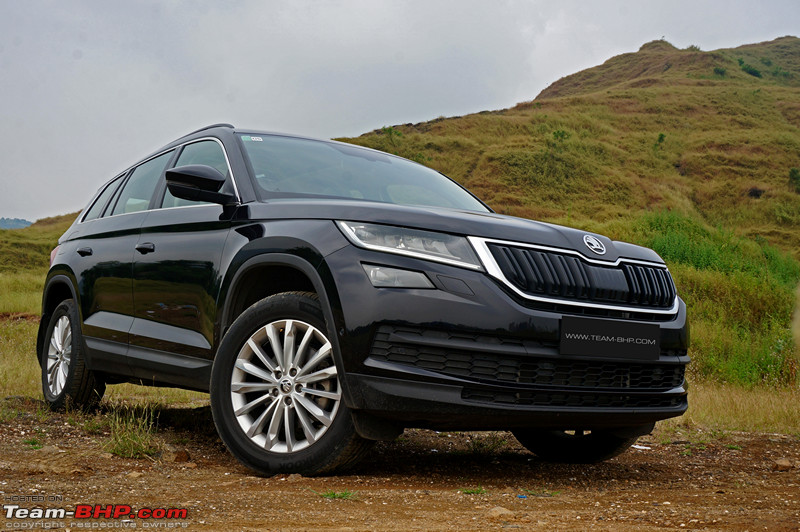 Skoda has been banking on sales of their sedans for business in India. The Rapid, Octavia and Superb are bread and butter models for Skoda. They did try venturing into other segments with the Fabia and the Yeti, but both met with lukewarm responses. Internationally, the Fabia is still on sale and the Yeti has done quite well, garnering 10% of its total sales. For India, one can say, the Yeti was ahead of its time. When it was launched, it's only competition was the Honda CR-V and the Maruti Grand Vitara. Both of these were petrol only CBU's while the Yeti had the USP of diesel power plus being locally assembled. Unfortunately, the Indian market wasn't ready at the time for a premium 5-seater crossover. The quirky styling of the Yeti didn't help matters. That said, ask any Yeti owner if he's happy with the car and you'll most definitely receive a positive response. Today, if you don't have an SUV in your line-up you stand to lose big time not just in India, but worldwide. SUV sales shot through the roof and are only increasing. Heck, even Lamborghini have just announced their SUV offering, the Urus. After the Yeti, Skoda knew they needed a proper SUV. At the 2016 Geneva Motor Show, Skoda showed off their plans for a full size SUV with the VisionS Concept (Click here to read the preview). The VisionS concept was a 7-seater SUV also available in a 5-seater option. The production version of the car was later unveiled in August 2016 which was clearly toned down from the concept, but had the quintessential characteristics of the VisionS. The SUV was named as the Kodiaq and made its global debut at the Paris Motor Show 2016. The Kodiaq has been launched only in a single variant (Style) at Rs. 34.50 lakhs (ex-showroom). Rather than launch multiple engines and trims, Skoda has gone with a single fully loaded trim. Skoda's reasoning is that majority of the buyers in this segment opt for the top spec variant anyway. The Superb and Octavia also have the highest demand for the top spec variants. Though this could change once demand picks up and supply internationally is sorted out. Skoda has high hopes from the Kodiaq internationally. In fact, the Czech manufacturer has recently released a statement saying that this year, they have reached the 1 million car production mark in record time and that the Kodiaq has contributed in increasing the production volume of the total numbers for Skoda. Skoda even sells a 5-seater version of the Kodiaq, but that's probably not going to work as well in India since we like our SUV's with 7 seats. Besides, Skoda have a smaller SUV, the Karoq that is a 5-seater. Skoda will be assembling the Kodiaq at its Shendra plant near Aurangabad, Maharashtra. Even though the Kodiaq is a CKD, Skoda is pricing it at a premium vs other SUVs in the segment. There are high hopes from the Kodiaq, and it looks like the Czech manufacturer wants to maximise their profits rather than go for volumes from initial sales, before introducing any other variants. Skoda's only competitors in this segment are the Endeavour and Fortuner. VW's Tiguan even though priced close to the Kodiaq is a 5-seater and it looks like VW themselves aren't too keen on selling it after the Kodiaq launch. Currently the Fortuner leads this segment by a huge margin followed by the Endeavour at a distant second. Both the Ford and Toyota are big burly SUVs built on old school ladder frames and are designed for rugged use. They have proper 4x4 hardware for challenging terrains. While the newer gens of these SUVs bridge the gap between an SUV and a crossover, they still don't come close to the driving experience of a monocoque vehicle. It is the Kodiaq that brings a car-like experience here. It offers the 7 seats option similar to the SUVs as well as an AWD for most situations. But it drives like a car, is loaded with features that the Fortuner and Endeavour can't match and has an interior quality that comes closer to the Superb than to these SUVs. All of this in an understated design that occupies a lesser footprint as well. Skoda is basically repeating the Superb recipe in the SUV space with the Kodiaq. Other than the badge, the Kodiaq can even give the big 3 (Mercedes, BMW and Audi) a run for their money. The Kodiaq offers so much more car for a price that's lesser than the tiny Q3. Going by the volumes in the first 2 months, it looks like Skoda's strategy has worked for them. This also makes way for lower trim levels to come in later and build upon the foundation set. We also know Skoda is planning the smaller Karoq for India next. The Kodiaq is the first car that's part of Skoda’s Strategy 2025 SUV campaign. It is also one of the last cars to be designed by Jozef Kabaň who designed the outgoing Superb and the 3rd-gen Octavia. The SUV gets its name from the Kodiak bears found on the Kodiak island (Yes, you read it right). The island is located off the southern coast of Alaska and the natives call the bear Taq uka 'aq, and Skoda used the last ‘q’ instead of the ‘k’ to name their SUV. At the launch event, they had even invited the Mayor of the island. As mentioned earlier, the Kodiaq is offered in just one variant, and gets a 2.0 litre diesel engine which is mated to a 7-speed DSG gearbox with an on-demand AWD system. We don’t get either of the 3 petrol powertrains available internationally. The 2.0 L diesel engine is available only in the lower 148 BHP tune, whereas internationally Skoda offers it in a 188 BHP tune as well. Later on, you will read that the 148 BHP is adequate, but Skoda should have gotten the higher tune considering the price point and target audience. Many enthusiasts have expressed concerns over the lower state of tune being made available for the Indian market, and that Skoda should have gotten the higher state of tune at this price point. While power delivery is 'adequate', it is certainly not 'special'. 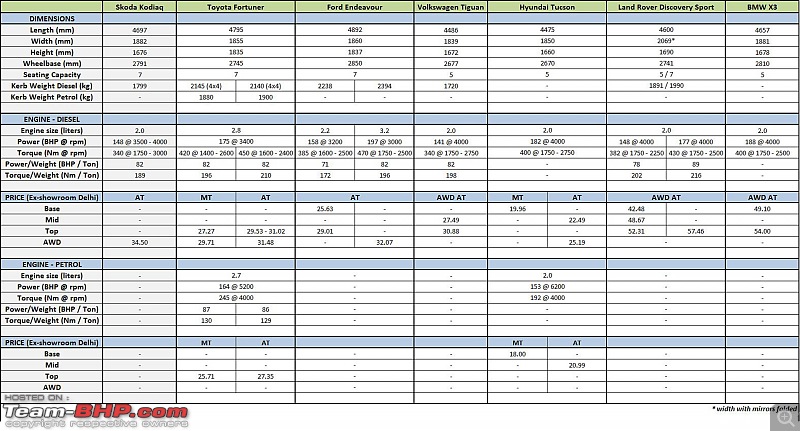 The Kodiaq is based on Volkswagen’s Modular Transverse Matrix platform commonly known as the MQB. Other cars based on the same platform are the VW Tiguan, Audi A3, Skoda Octavia & Superb. The only fixed components in the MQB platform include the area between the front axle and the front bulkhead which has the HVAC system, the pedal box and the engine position. All other factors can be configured as per the required design. The Kodiaq measures 4,697 mm in length, 1,882 mm in width and 1,676 mm in height. The wheelbase is 2,791 mm and the laden ground clearance is 140 mm (188 mm unladen). Looking at the dimensions, you will notice that the Kodiaq is not that big a car. For reference, it is merely 27 mm longer than the Octavia. Head on with an Endeavour or a Fortuner, the Alaskan bear does seem smaller. Skoda has always managed to make their cars better looking than their VW siblings. The Kodiaq is no different. It still has the classic, elegant and understated looks like the Tiguan, but is slightly edgy which makes it much more pleasing to look at. It does not have the sheer macho or butch presence like the similarly priced Fortuner or the Endeavour though. The 7-seater SUV in fact looks tiny in front of any of these as the Skoda is more of an urban SUV rather than a full-fledged offroader. Without much street cred, it doesn't stand out in the crowd, rather blends in with it. Fit & finish are top class. The build quality is typical European and there are no uneven panel gaps that you will find on the car. The kerb weight of the Kodiaq is 1,799 kg which is 79 kg more than the 5-seater Tiguan. The lightweight materials used on the MQB are responsible for the low kerb weight, but that isn’t translated into the build quality as the hot stamped metal sheets contribute to the sturdy construction. The sturdy construction is visible when you want to open the bonnet (quite heavy!) or the doors as they shut with a reassuring thud seen in most European cars. The paint quality is good throughout and there is minimal flex when you try to press the metal panels. The 5-seater version of the Kodiaq recently received a safety rating of 5 stars from Euro NCAP (detailed report here). Equipped with a total of 9 airbags, 3-point seatbelts for all passengers, ABS + EBD, TCS, ISOFIX child seat mounts, driver alert system and some more safety equipment, you could say that the Kodiaq is as safe as they come. Skoda gives you a 4 Year/1,00,000 Km warranty as standard, and a 4-year maintenance package as well. Up front, the look is classy and simplistic. No excessive use of chrome and nothing is disproportionate to draw attention to that part of the car. It’s not bland, but it’s not flashy either. It sits comfortably in the zone of being understated: 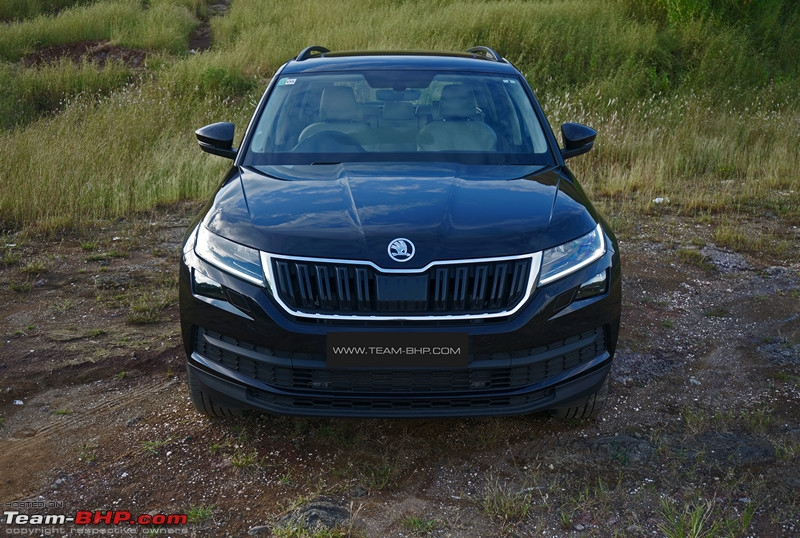 The rear is edgier than the front for sure, but it doesn't have presence. Body lines are distinctly visible accompanied by sharply designed taillights which Skoda calls 'crystal design'. Nope, no chrome here except for the badges: 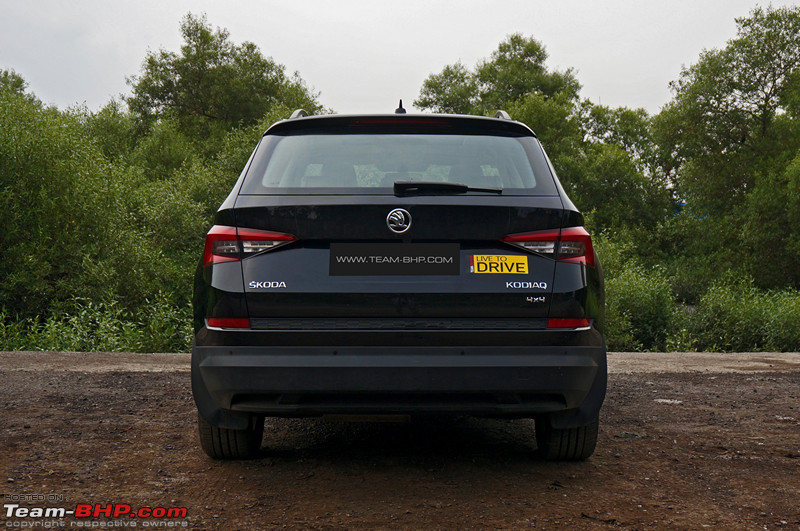 Overall the Kodiaq's dimensions are quite proportionate. Even though it's length is lesser than the Fortuner's, it has a longer wheelbase (2,791 mm). This accompanied by the overall length makes the Kodiaq look well planted on the ground. The squared off wheel arches occupy the 18-inch wheels properly. The Kodiaq has a laden ground clearance of 140 (unladen is 188 mm):  Looking at the car from this angle, many will comment that it looks like a jacked up station wagon / estate. And I won't disagree on that, but Skoda has beefed it up substantially to hide that feeling as much as possible. The all-round plastic cladding, beefed up wheel arches and overall raised stance work well to give it an SUV look, but it doesn't match the presence or the street cred of a Fortuner or an Endeavour:  The build quality of the car is solid, and you can see some of the crystalline design elements towards the rear. The paint quality is also very good:  The Kodiaq gets full LED headlights and DRLs. The headlamp cluster is narrow and meshes with the edge of the front grille. Despite being narrow, the headlamps are long and stretch back on the front fender: 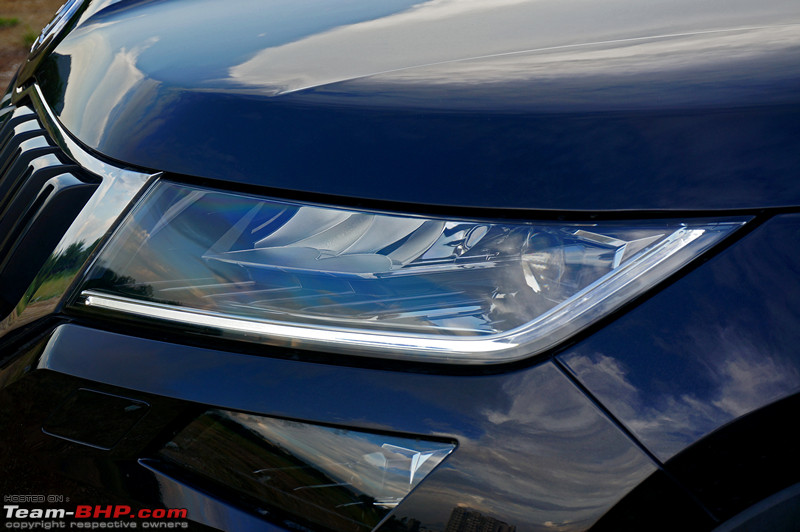 The LED fog lamps are placed just below the headlamps which is quite unusual and not seen on many cars these days. The trapezoidal fog lamps are placed beside the retractable headlamp washers: 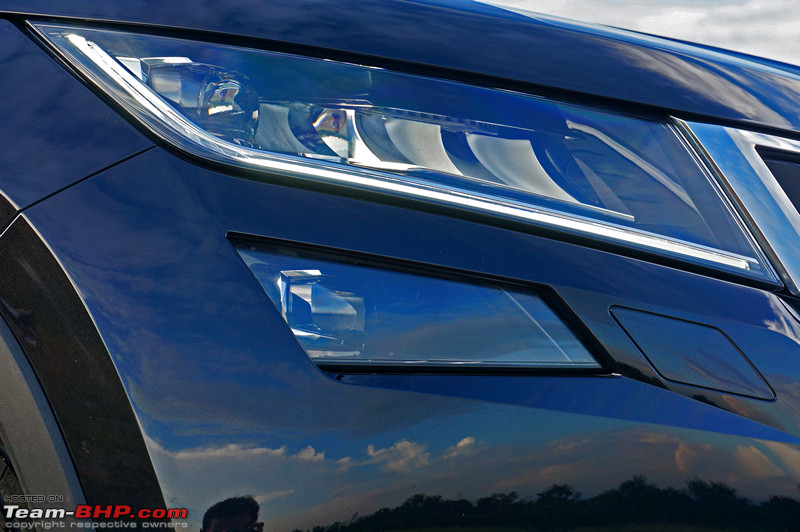 With all the lights in action. The auto headlamps are self-levelling & also have coming home and leaving home functions. They feature what Skoda calls as AFS (Adaptive Frontlight System) which adjusts the light intensity based on the surrounding conditions - for e.g. city, motorway or driving in the rain by changing the light pattern. It's pretty cool - check out the explanation on Skoda's website: 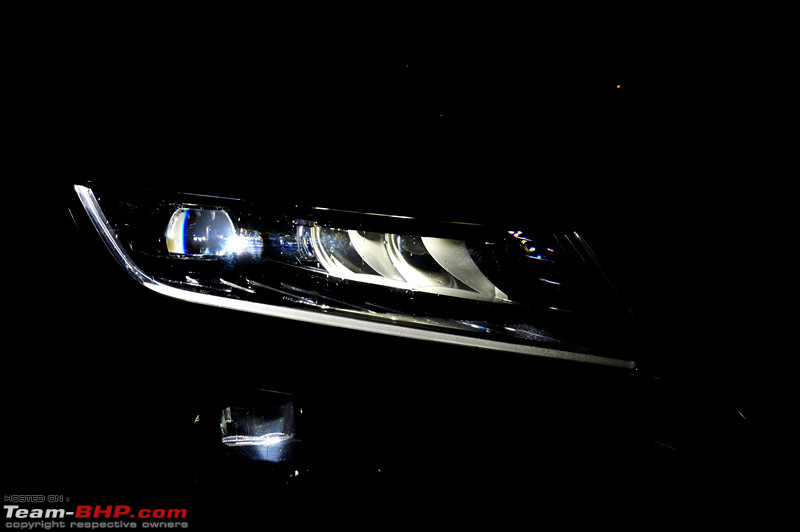 The DRLs are prominently visible on the road and… 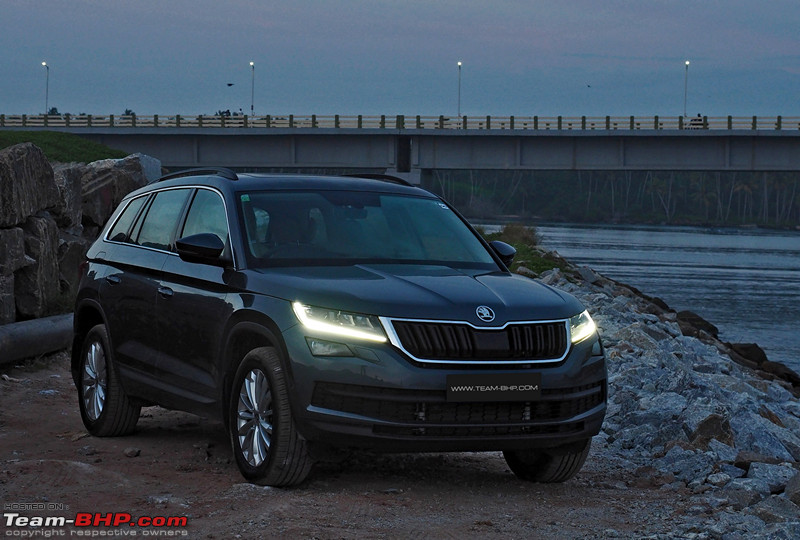 …they double up as turn indicators: 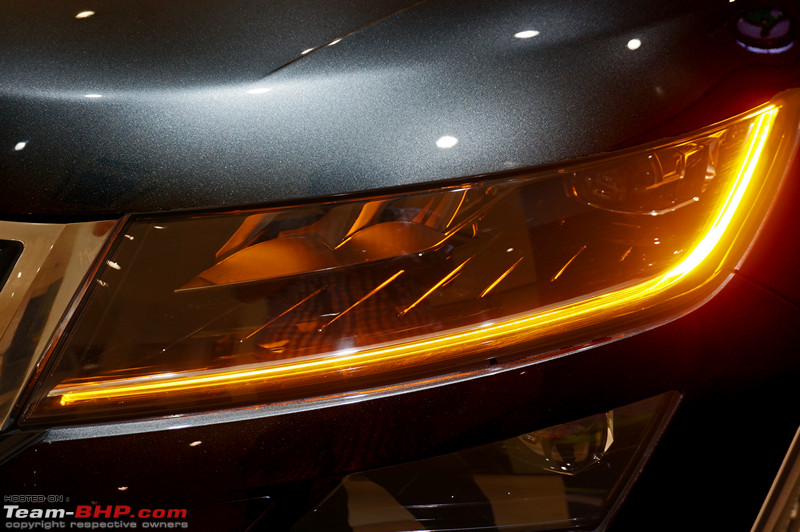 The signature butterfly front grille gets a chrome lining all around. The central part of the grille below the logo is basically a housing for Radar based systems on international models. In India, we don’t get Radar based driver assistance systems. Note the slim air inlet below the grille: 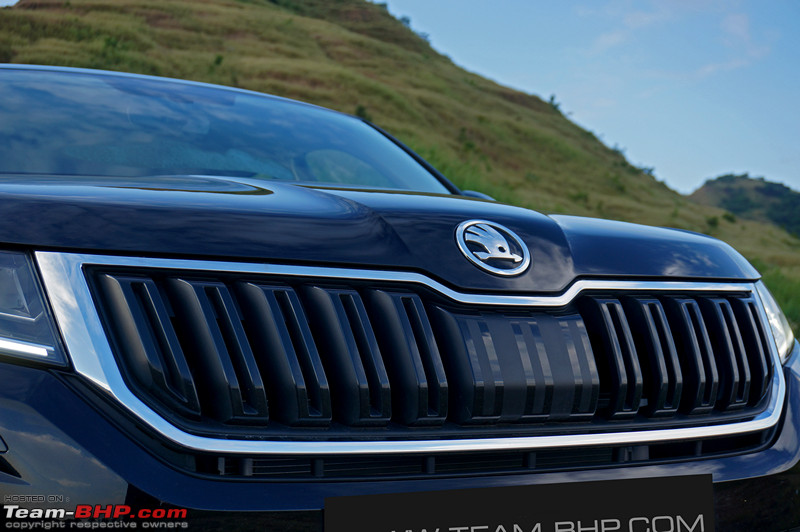 The grille and the headlamps look seamlessly integrated. The lower bumper features a split air dam with the actual air intake from the central part only, while the sides have been shut off. Check out the slim body coloured lip which splits the air dam:  The Kodiaq gets 3 parking sensors on each corner of the vehicle. Some of these are nicely integrated in the honeycomb structure of the air dam on the lower bumper. See that small hole in between the center and right sensor? Insert a clamp from the toolkit in there to remove that part of the air dam and you will see the slot to attach the towing eye:  A clean underbody from the front. The car gets a rough road package and underbody protective cover as standard:  The bonnet gets 4 creases overall with a prominent hump in the middle. The Skoda logo on the bonnet looks swell:  Windshield washers are neatly hidden under the bonnet: 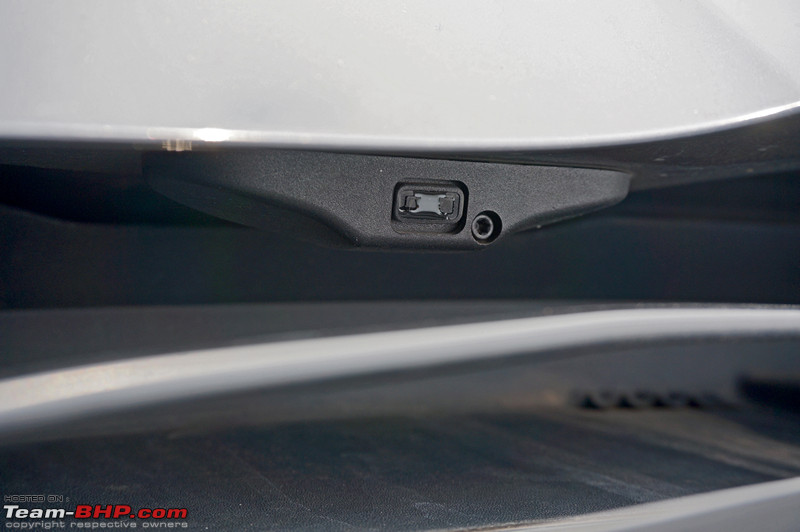 The washers squirt out sprays of water for a wider coverage. Also, the big wipers have a good sweep overall: 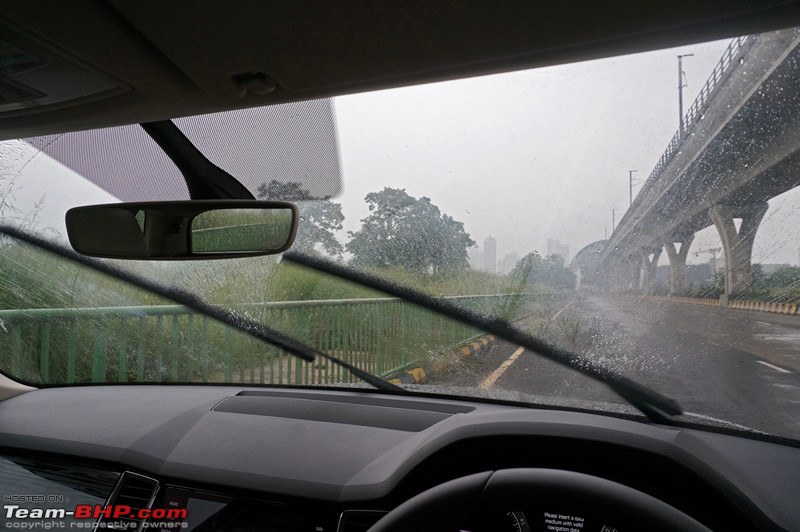 Just look at how tight and consistent the panel gaps are! 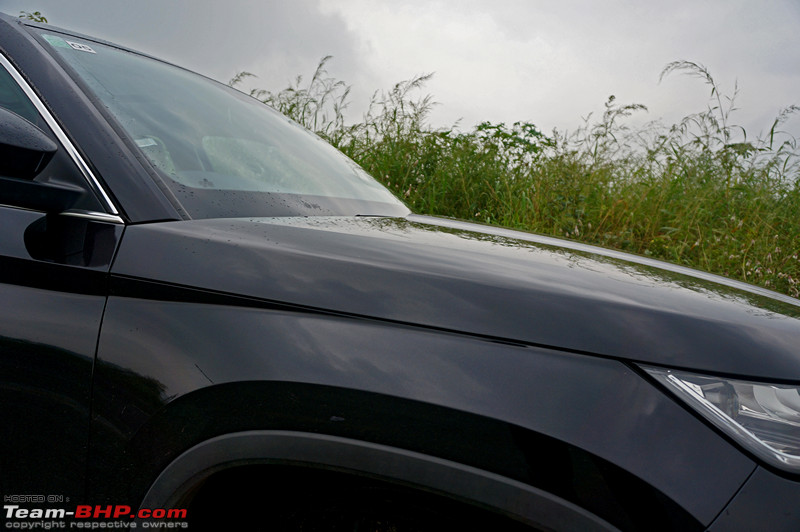 Flaps are placed ahead of the front wheels in order to aid aerodynamics: 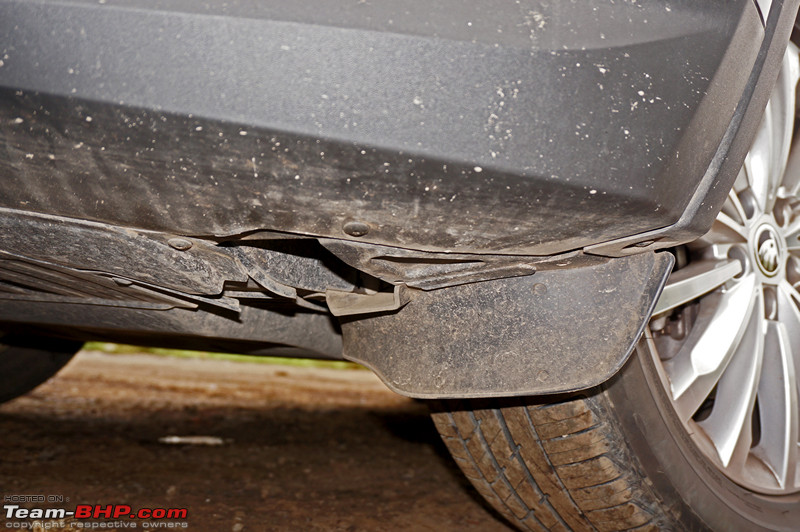 The front wheel wells get full plastic cladding… 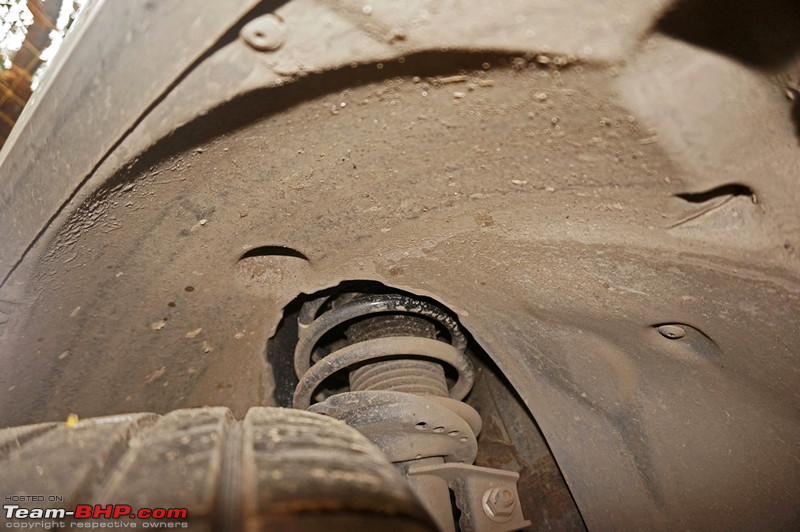 … and proper insulation for the rear wheels as well. This is not a car that went through any kind of cost-cutting exercise:  Vertical slots in the front to direct air in the wheel wells. These are claimed to reduce air drag and turbulence. Here’s an interesting article on the aerodynamic advantages of these vents (click here):  The Kodiaq gets 18-inch multi-spoke alloy wheels which Skoda likes to call as 'Trinity'. The wheels are shod with 235/55 section Hankook Ventus S1 Evo2 tyres (same as the Tiguan). The tyres are self-sealing, which means there is a liquid sealant inside the tyre which fills the leak when there is a puncture. This sealant takes care of most punctures, reducing the chances of getting a flat tyre while driving. Do note that 18" tyres won't come cheap when replacing. The tyres provide good grip even when you are pushing the car around in the corners. These are designed for sporty driving rather than a comfortable ride. That being said, the ride isn’t harsh as we had mentioned in the Tiguan: 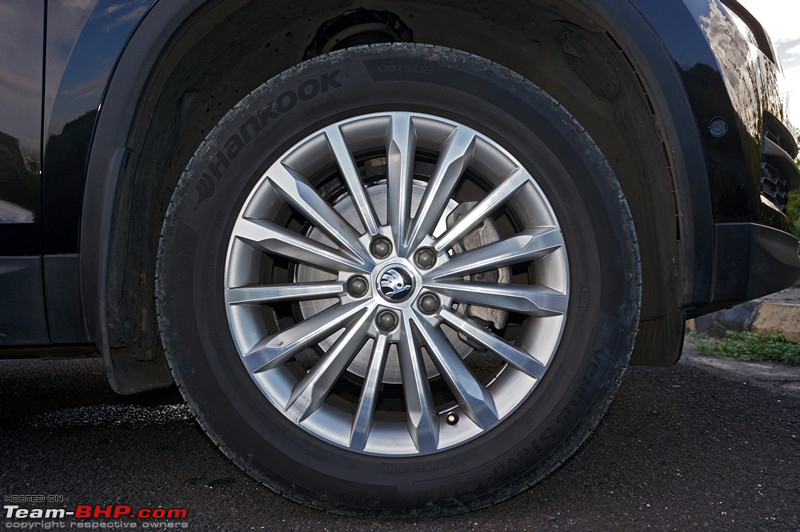 Just like the front, the rear tyres also get these aero flaps:  ORVMs are integrated with turn signals. They are electrically adjustable and foldable. They automatically fold / unfold when the car is locked / unlocked respectively: 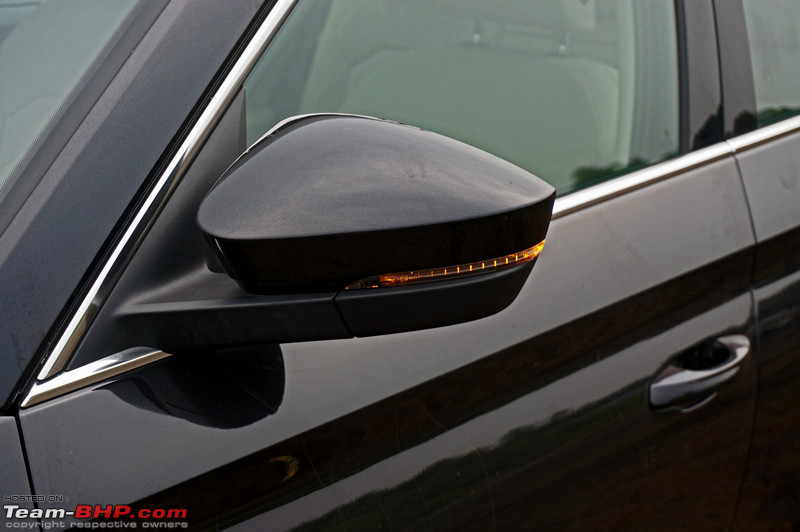 Puddle lamps are placed underneath the ORVMs: 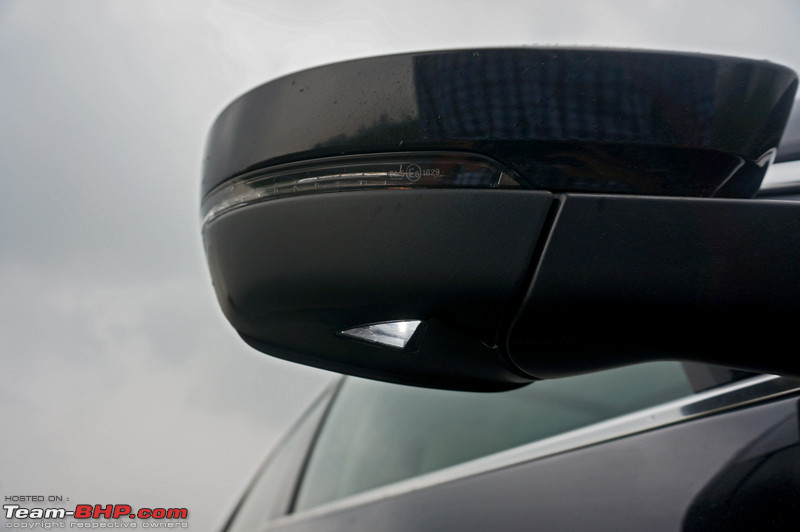 The passenger door gets a request sensor as well. Request sensor is a slim soft touch design, unlike the black physical buttons seen on most other cars (reference image): 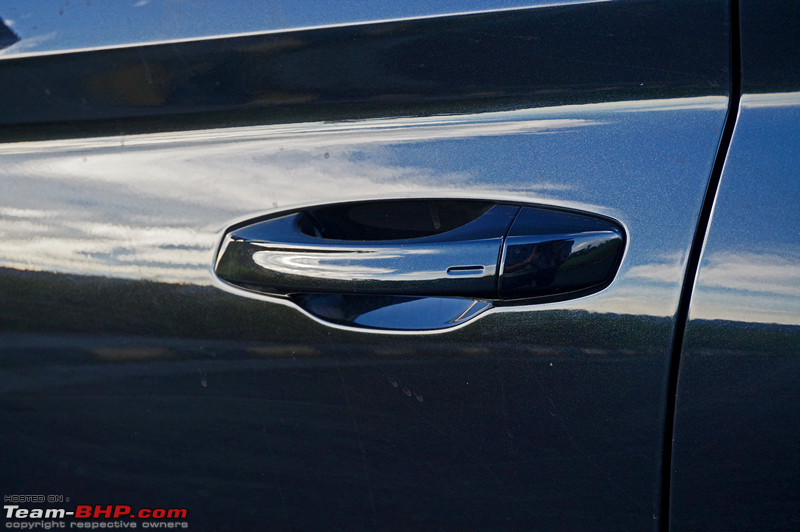 The greenhouse area on the Kodiaq is huge. The B & C pillars are blacked out and the glass area gets a thin chrome border which looks classy:  The panoramic sunroof’s front half opens outwards (looks ugly). The roof rails feel sturdy and are attached firmly:  The shark fin antenna is placed towards the end of the roof:  The front fenders are beefed up slightly. The clamshell bonnet has a tight shut line & continues to the side of the car to form a character line. This shoulder line continues along the door panels…  … up until the tail lamps, and swirls upwards to go onto the tailgate: 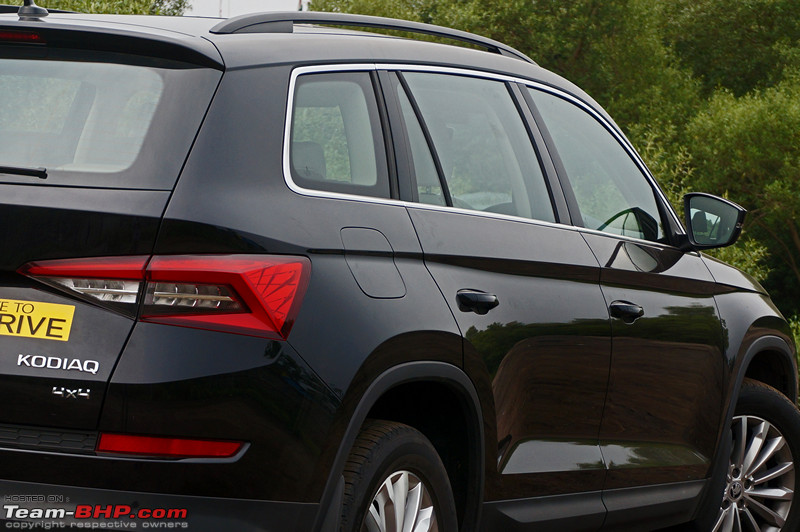 The plastic cladding on the side of the body also carries the edgy crystalline design theme. Similar to what we had seen in the Superb (reference image):  Check out how deeply the roof slopes towards the rear of the vehicle, giving it a squat stance. The rear windshield isn’t at a steep angle and the tailgate has some edgy contours with a kink in the middle. The wheel-tyre combo fills the wheel wells nicely: 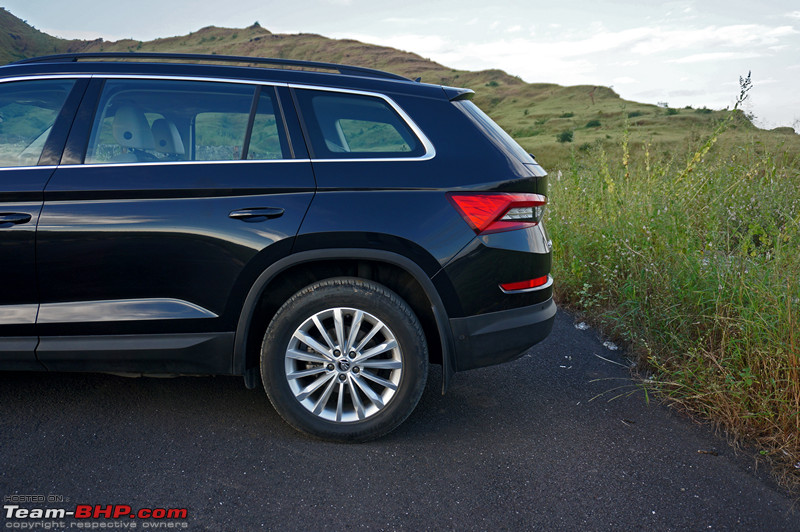 The C-shaped LED taillights have a lot of detailing. They are placed at the center of the kink on the tailgate: 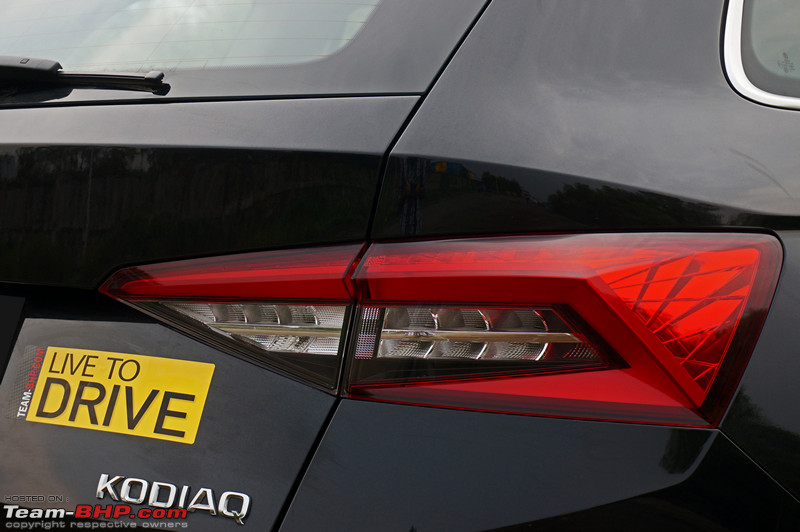 A closer look at the crystalline design element in the tail lamps. These elements are actually a tribute to the Czech glass-making tradition: 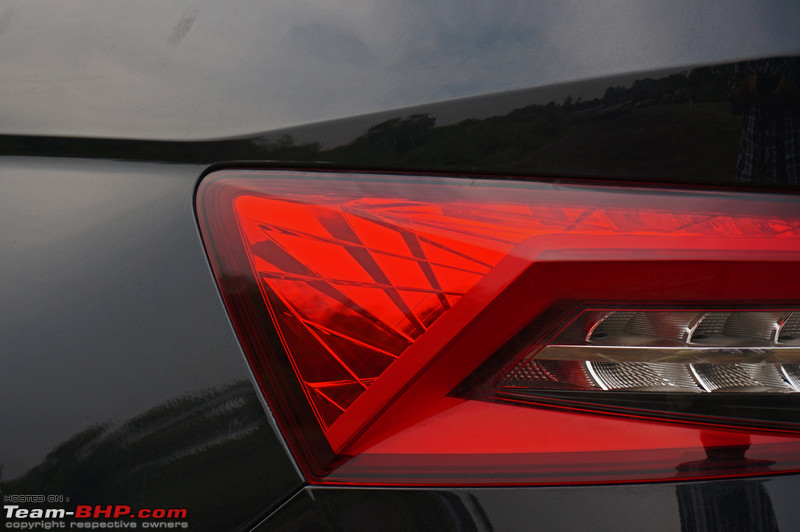 With parking lamps and the turn signal in action. The brake lamps are placed above the C-shape of the taillamp:  The taillamps look wicked at night. Check out the rear fog lamp in the right-hand side cluster:  Company badge on the left… 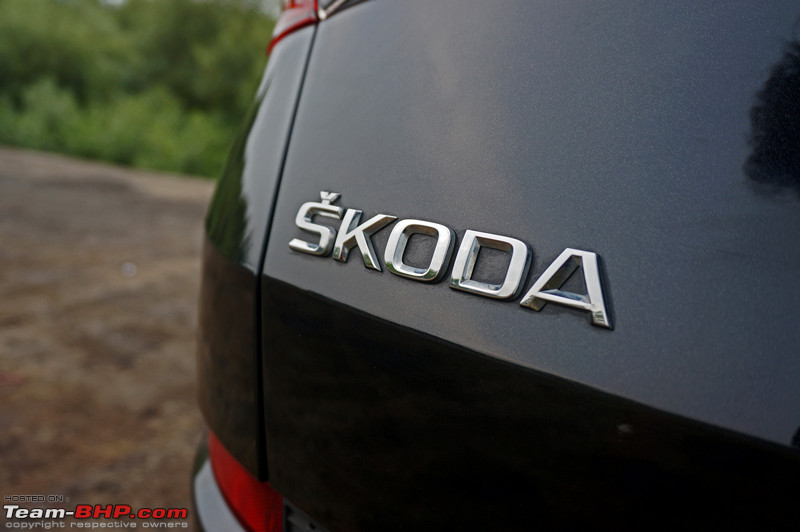 … and Kodiaq badge on the right. AWD is standard on the Indian car. We expect to see a cheaper FWD variant later: 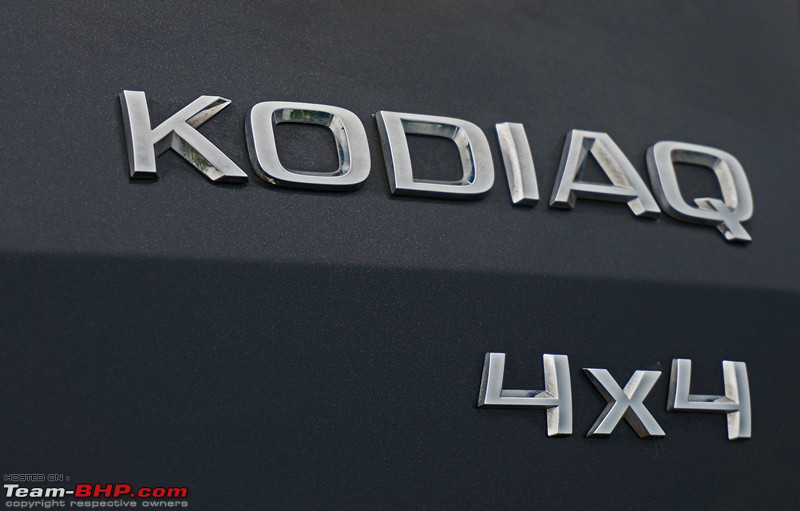 The roof mounted spoiler also houses the high-mounted stop lamp (HMSL):  The rear windshield washer is integrated in the HMSL and sticks out a bit, but not too much due to the colour-matching:  With the HMSL and brake lamps in action: 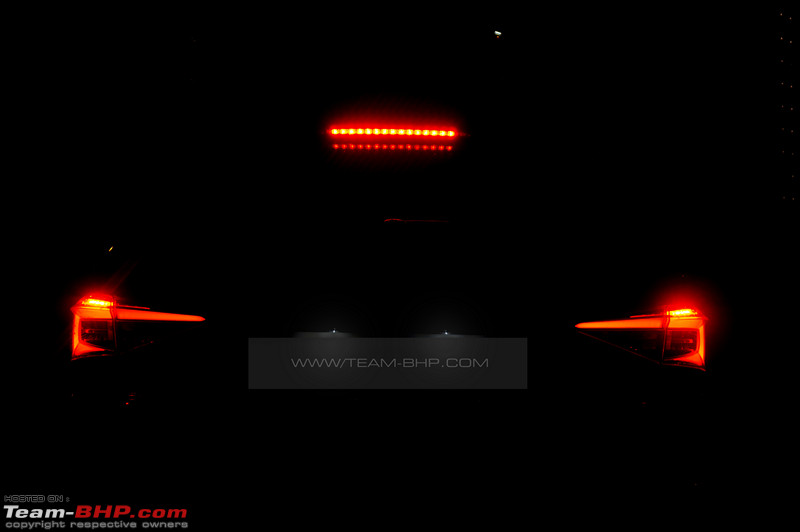 The rear windshield is fairly sized, and the wiper has a good sweep: 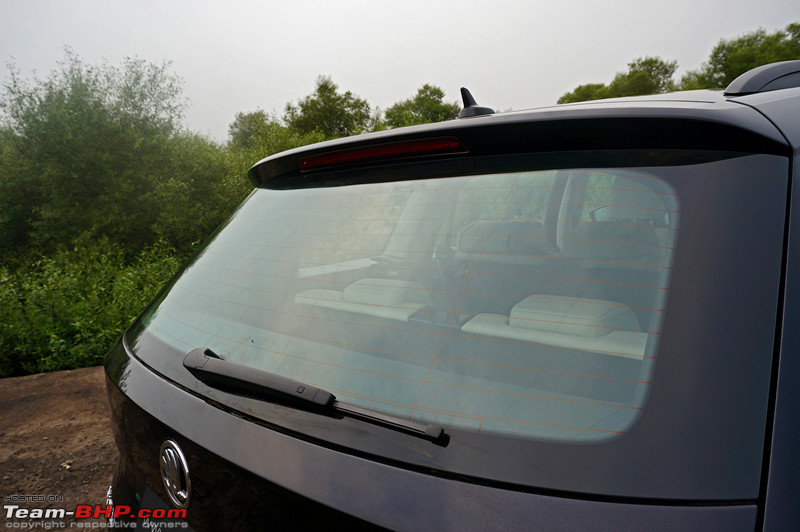 Reversing camera is neatly integrated and located just above the number plate to the right of the electromagnetic boot release. Considering the poor rearward visibility of the car, you will need to use the camera more often than not: 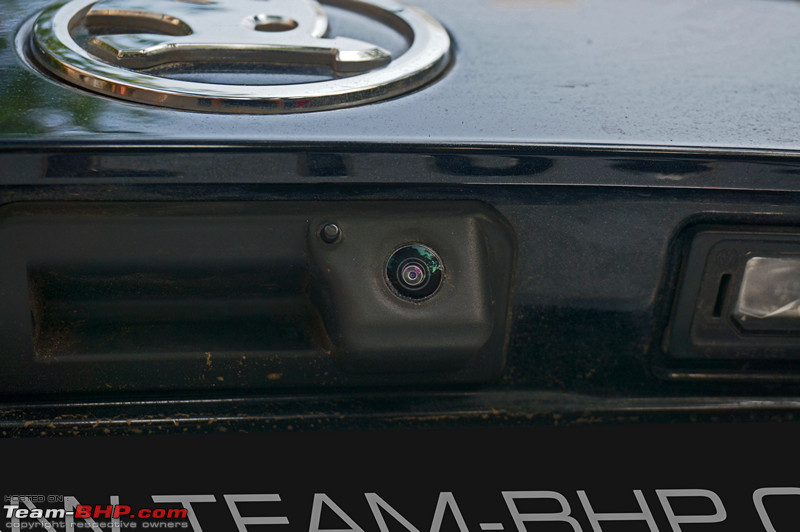 The rear bumper houses safety reflectors at the bottom. The 2 safety reflectors are connected by a plastic trim which also bears the honeycomb design that is seen on the front bumper. The honeycomb strip is the shut line for the tailgate. This way, while loading & unloading, the baggage won’t scrape the body coloured bumper. The lower part of the bumper has a diffuser-like shape and also houses the 6 parking sensors: 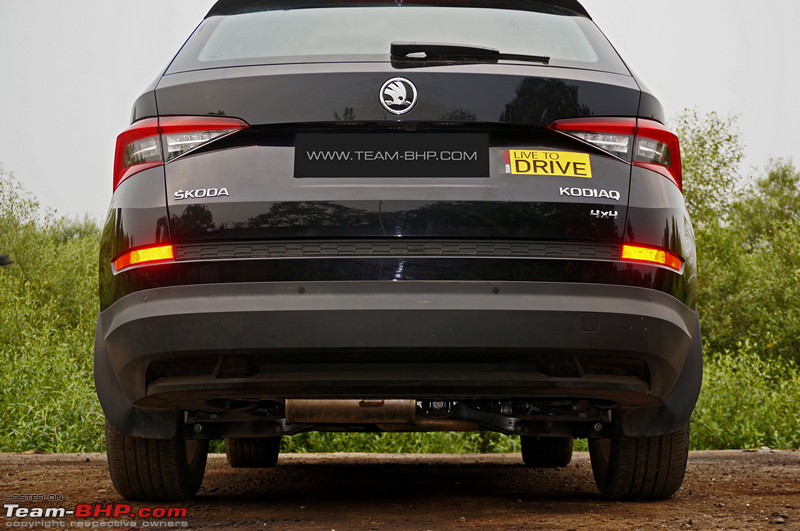 Twin exhausts pointing downwards. The exhaust isn’t visible when viewing the car from behind. Also note the multi-link suspension at the rear: 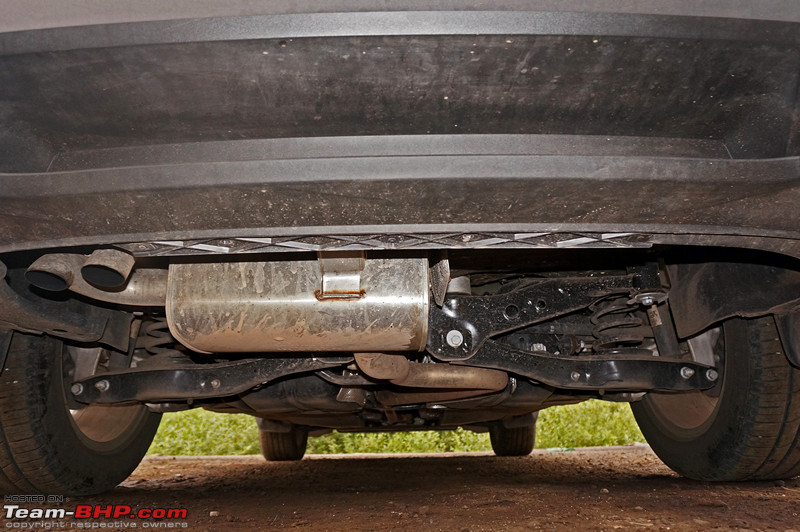 The front axle gets a MacPherson strut suspension: 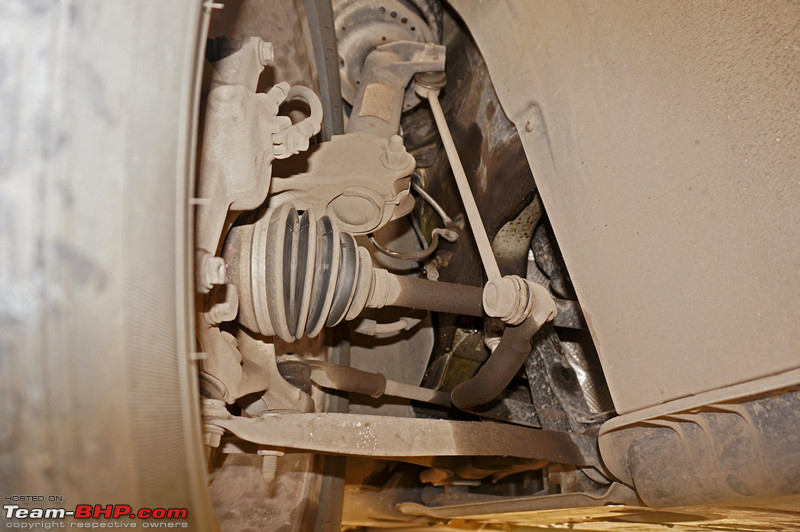 The 63-litre fuel tank is a size too small for a 7-seater. The size is in the range of the Tucson (62L) and the Compass (60L). Even the Tiguan gets a larger 71L fuel tank:  The brawny vs the classy. The Endeavour has visibly longer length, wheelbase and height. Although, the Kodiaq is wider than the Endeavour by 22 mm: 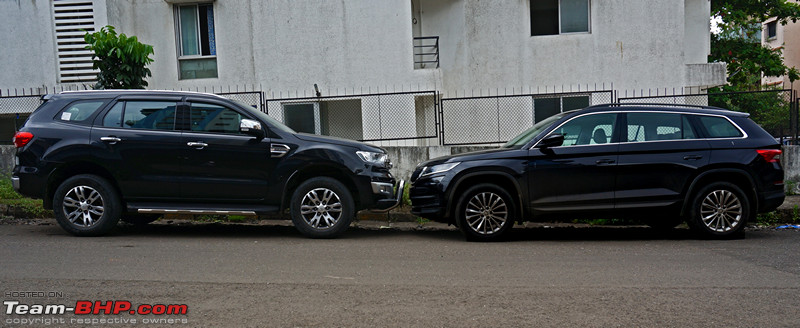 A parting shot: 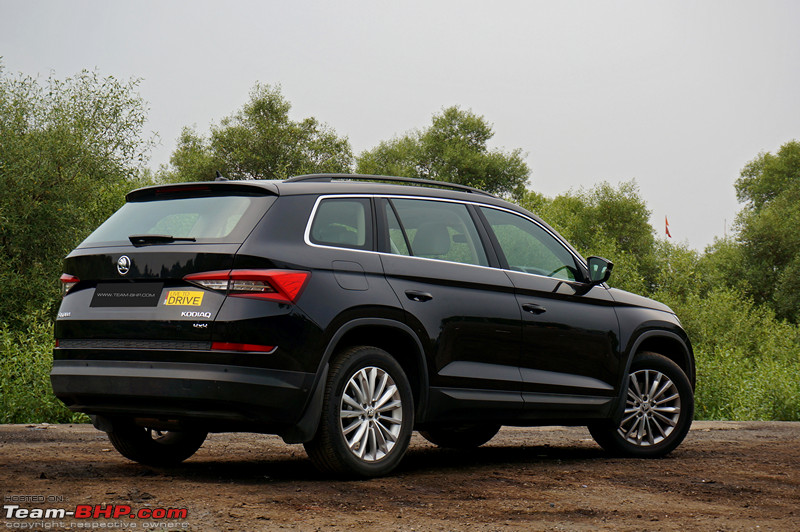 Last edited by Rehaan : 29th December 2017 at 15:56. |
| |  (51)
Thanks (51)
Thanks
|
| The following 51 BHPians Thank Omkar for this useful post: | Aditya, akshay81, AShubrah, CarguyNish, CEF_Beasts, Chethan B G, cn.vishnu, deetjohn, Dr.Vikas, DrANTO, F2005, GTO, Hayek, iliketurtles, Impala_123, InControl, Jaggu, JTM, kbishwa, lemedico, Leoshashi, N33raj, noopster, NPV, Obi-Wan, pankaj_sachdeva, parsh, phoenixash, pratika, pulsar56, RaghuVis, RavenAvi, Rehaan, sandeepsarma, sangam_mm93, SDP, Simat, smuniswami, sparky@home, suhaas307, sunny29584, theexperthand, vaasu, Varun_HexaGuy, vb-saan, VeluM, vibbs, Vid6639, Vik0728, viXit, vredesbyrd |
| | #4 |
| Team-BHP Support  Join Date: Apr 2016 Location: Mumbai
Posts: 2,998
Thanked: 29,641 Times
| Interior - Front 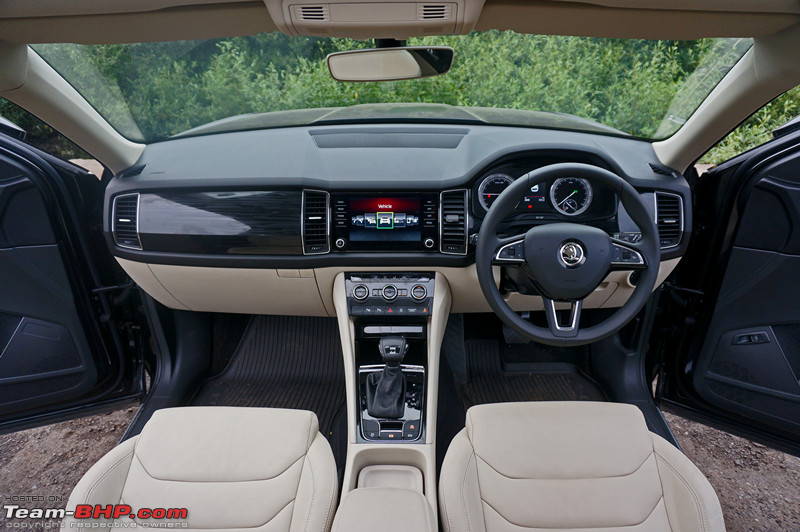 Walk up to the car with the key in your pocket, pull on the door handles and the first thing you will notice are the heavy doors. They open & close with a three-stage action and shut with a solid reassuring thud to isolate you from the outside noise. Getting in and out of the front seats isn’t much of an issue, as you can just slide into the seats easily. This isn't an SUV where you have to climb into, like the Fortuner or Endeavour. Senior Citizens will be very happy at the ease of entry / exit. Once inside, the design, switchgear and controls will be very familiar to folks who have sat inside Skoda cars. Superb owners will draw out a lot of similarities. On the inside, you are greeted by a clean dual-tone black and beige cabin. The beige colour along with a large greenhouse area makes this a light and airy cabin. To distinguish the cabin from sedans like the Superb, Skoda have gone with a vertical layout of the dash. The aircon vents are vertically placed giving the dashboard a tall look. There are no wooden inserts, instead you get a black veneered finish. The materials used in the cabin are of top quality and there are quite a few soft touch materials which raise the overall luxury quotient. Just like the exterior, there is subtle use of chrome which adds to the classy theme that the cabin carries. The overall design though contemporary, lacks that ‘WOW’ factor. That said, overall cabin feel is still far ahead of both the Endeavour and Fortuner. The Kodiaq has loads of features which includes electric seats with memory presets for the front seats, ambient lighting which has 10 colour options, 3-zone climate control, auto headlamps, auto wipers, 8” touchscreen unit with 10 speaker Canton sound system and Android Auto & Apple CarPlay. In terms of ergonomics as well, the buttons for various operations are well laid out and you won’t be stretching way too far for anything. The fit and finish is excellent - plastics on the top part of the dashboard and the line running below the infotainment system are soft to touch. The lower dashboard gets hard plastics (but still of good quality). The switches feel durable and are nice to operate. A lateral shot of the dashboard. It is clear from the specifications that the Kodiaq is wider than the Fortuner or the Endeavour. The same is reflected inside the cabin as well. The wide cabin ensures that the driver and passenger aren’t seated too close to each other. There is enough headroom once seated inside the cabin:  Frontal visibility is good as you get a nice and high driving position. It’s not very tall like a typical SUV, but more like a raised sedan:  The A-pillars don’t hamper visibility too much:  The steering wheel is identical from the one found in the current gen Superb and Octavia. It’s good to hold with the sculpted thumb contours while the horn pad isn’t much of a stretch either. Piano black and chrome has been added tastefully:  A close look at the leather stitching on the wheel: 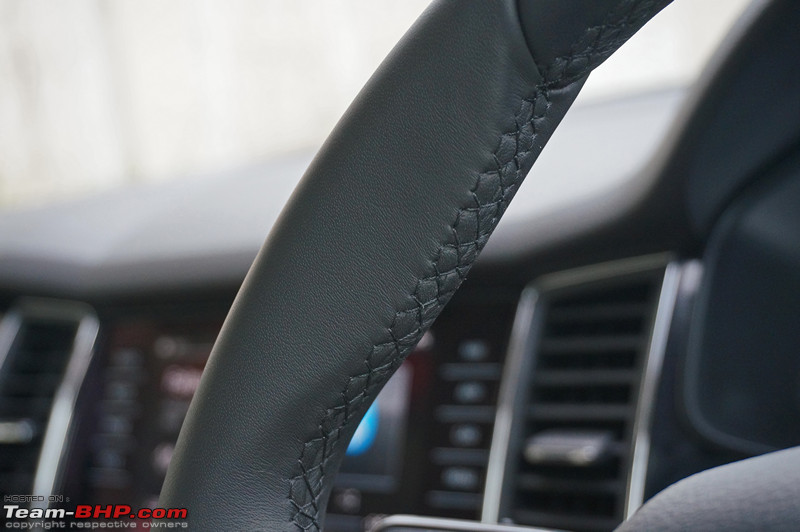 LHS buttons are for audio & voice commands, while the ones on the RHS are for the MID & telephone. Scrollers are fantastic to operate! Press the volume knob inward to mute. The button above the phone icon (on the RHS) is for the driver assist menu. Pressing it shows there's nothing on the Indian car (lane departure warning, blind spot monitoring, etc. are available on the international variant):  Paddle shifters on either side of the steering in black - one on the left is for shifting down and vice versa. While the shift time is decent, they are made of plastic and hence have a clicky feel to them. Should have been constructed of metal. A point worth mentioning is that they are fun to use (more on this later):  Steering offers tilt & telescopic adjustment. Both have a healthy range:  The instrument cluster is similar to what we see in the current Octavia with 2 prominent dials and a retro feel. The revv counter is placed on the left while the speedometer is on the right - just the way we like it. Look closely and you will see a slim chrome outline on both the dials. Analogue temperature and fuel gauges are placed inside the tachometer and speedometer respectively:  The dials and needles are backlit in white. Check out all the warning lights in the tachometer dial:  Skoda logo appears on the MID when you start the car. Operation of MID is fairly easy and user friendly with many options available in the main menu. These include vehicle options, driving data, navigation, audio and telephony options: 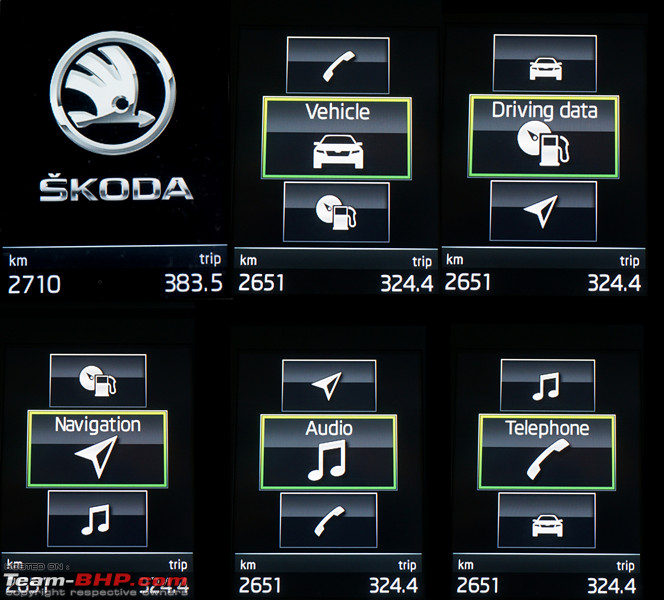 The MID is well sized and has a colour display. The current gear position is displayed on the top right and time on the top left, with a compass in between them. The outside temperature, tripmeter and odometer are displayed at the bottom. Different vehicle related information is displayed on the MID which includes current speed, average speed, range, travelling time, distance to empty counter, average fuel economy since start or refuel, real time fuel economy and oil temperature. You can even set the speed warning from 30 km/h to 250 km/h and check the warning messages if any (e.g. washer fluid low, coolant level low). When connected via Bluetooth, the current song title can also be displayed: 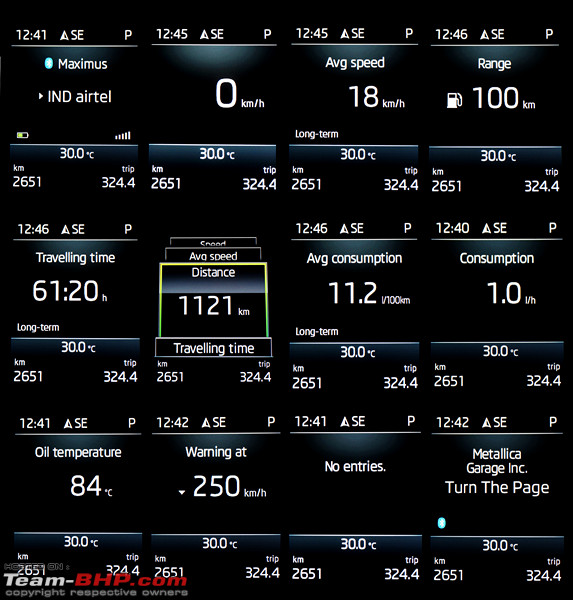 You can have a compass on display while driving. On entering a particular destination, the navigation gives you different options and calculates the route accordingly. The directions are displayed on the MID clearly with the direction and distance till the next instruction at the center. The current road is displayed at the bottom and the estimated time of arrival is displayed on the top right (13:07 in 3rd picture) & the distance to the destination is displayed on the top left. One of the coolest features on the MID navigation is that on a multi-lane highway, it shows exactly which lane you should be taking by crossing out the lanes which you should not be taking. The small green bar in the 4th picture is the car's position which moves as you approach the turn. The last destinations are easily accessible through the main menu. Press the voice command button and the green symbol pops up on the MID asking you to give the command. You can also access the call log from the MID and the screen also shows when the system is connected to Apple CarPlay via USB: 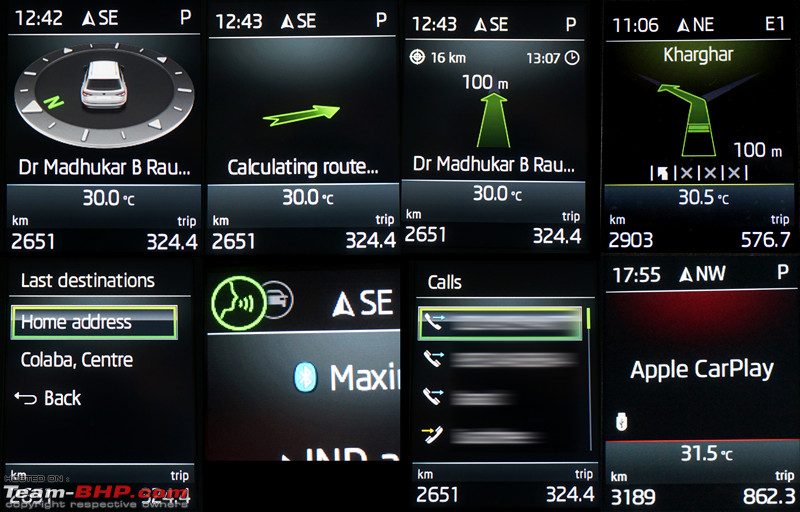 The Skoda Kodiaq features auto park assist which was introduced with the Octavia. To check out the hands-free parking feature, click here. There are different warning messages displayed on the MID. A message pops up as soon as the key leaves the vehicle when running. The traction control activation & deactivation is notified on the MID. If any of the doors or bonnet / tailgate is open, it is shown in red on the MID. Since we do not get any radar assistance options, the assistance menu is empty. If the key fob battery dies, the MID shows you a warning to hold the key (back of it) next to the intended surface which is the engine start/stop button. The MID displays the journey information every time you turn off the car and step out - distance, average speed, time and average fuel consumption:  The indicator stalks are shared with the Superb. The left light / indicator stalk also houses the cruise control options. You can activate cruise control at a minimum speed of 20 km/h, and accelerate from the stalk at increments of 1 km/h. Tap the light stalk softly for the 'lane change' indicator. On the right is the wiper stalk. Keep it in the INT position to activate the automatic wiping. Pushing it towards the dashboard activates the rear wiper:  Just like all other Skoda cars, the engine start/stop button is placed on the right side of the steering column. This is also where you have to place the key if its battery has drained and the vehicle is not able to detect the key. Note the chrome ring around the button:  The button is backlit in white at night:  The vertical air con vent gets a chrome lining around it. The vent can be shut by using the knurled dial below. Notice the black veneered finish on the side: 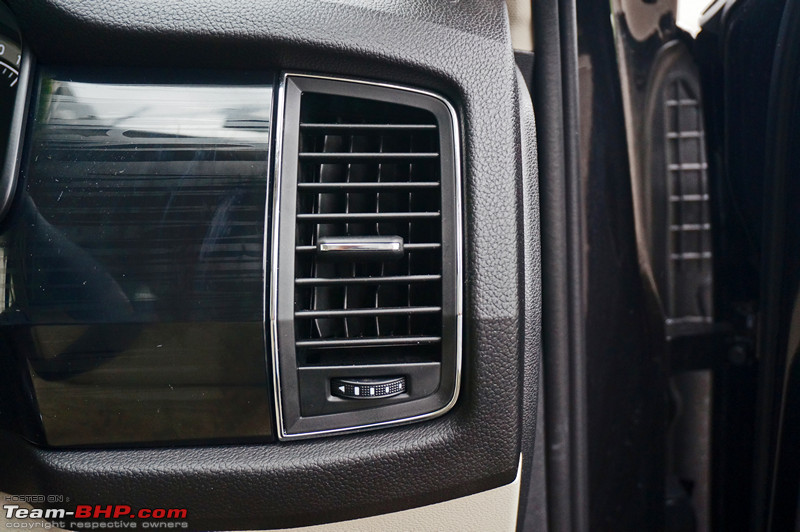 Typical European headlamp and foglamp controls. The Kodiaq gets automatic headlamps. Turn the switch to the parking light or headlamp position and then pull it slightly to the first step to turn on the front foglamps. Pull further to the second step to switch on the rear foglamp:  A useful storage space just beside the headlamp controls. It has a felt lining at the bottom and is perfect to hold loose change and other stuff: 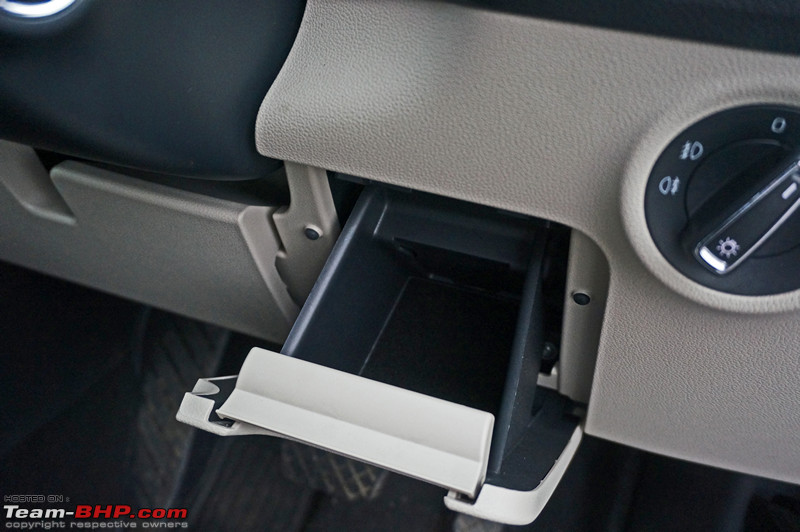 Look below the steering wheel and you will see the OBD port in purple, next to the footwell light:  Bonnet release lever is placed on the right side of the driver's footwell like the Tiguan. The lever is chunky and sturdy. To pull it, you need to open the door first! This is for safety, but very inconvenient when a hotel's security guard asks you to open the bonnet for inspection:  The doors open in a 3-stage action and are heavy. The doorpad carries forward the black and beige theme as the dashboard. The top part of the doorpad gets soft touch plastics and houses the black veneer finished trim along with the ambient LED strip. The tweeter is placed at the top near the ORVM housing while the mid-range speaker is placed at the bottom beside the door pocket:  Skoda calls this 'simply clever' and it's probably one of the coolest but simplest features that all manufacturers should have on their cars. The doors come with these edge protectors that pop out when you open them!! This prevents the door edge from hitting the wall or another car and chipping off the paint. A feature seen on the Ford Focus as well. Only downside is the local washing boy might damage them when wiping the car down if it gets stuck in the cloth:  The door seals do a good job of isolating the cabin from outside noise. Note the felt window lining on the top:  The elbow rest and area on the side are finished in leather. The compound is soft enough and comfortable to use while driving. Also note the dashboard trim above the beige area which gets an ambient light strip: 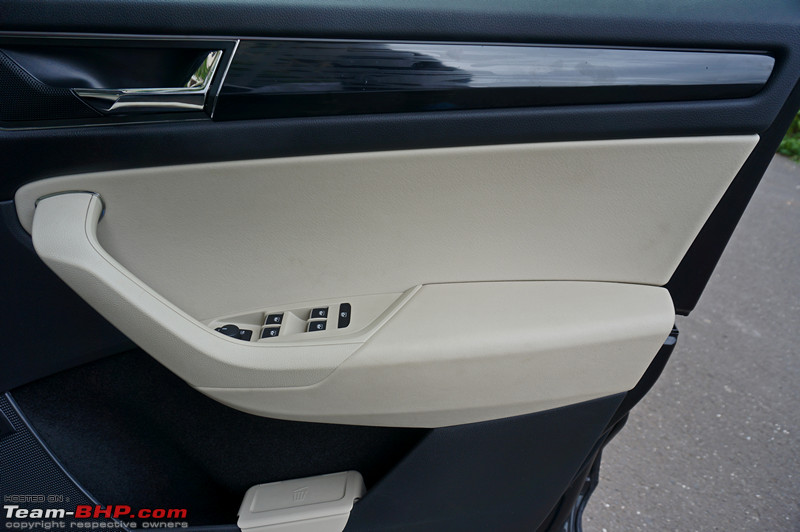 The ambient lighting has 10 colours. Here's a look at the colours at night:  Just like the Superb, you get a handy umbrella placed inside the door frame. Skoda have even provided a drain hole, so don't worry when stuffing a wet umbrella in there:  Chrome door handle looks sharp and very much in line with the crystalline design theme. Do note the thin chrome lining surrounding the door handle housing: 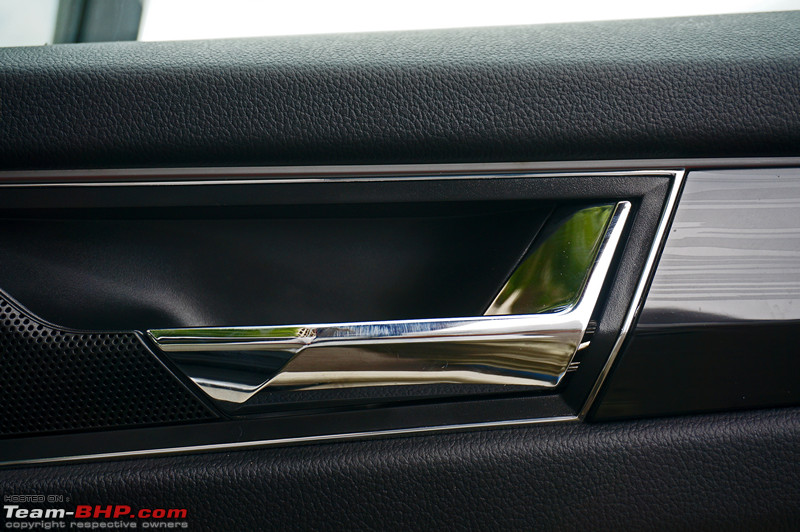 All 4 power windows get auto up and down functionality. Buttons are illuminated too. ORVMs are electrically adjustable and foldable, and get the auto-folding function. Notice the silver inserts on each of the window buttons: 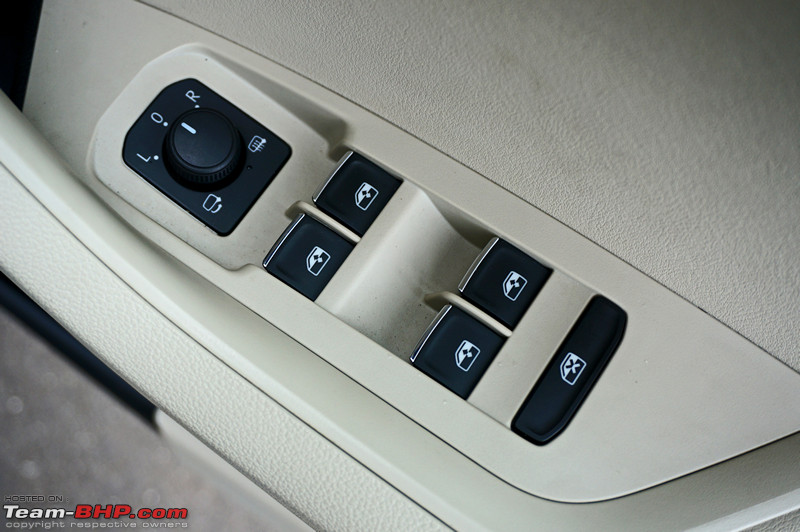 The boot release button is placed on the door pad, just above the speaker:  The front door pockets can accommodate 1.5L bottles and other knick knacks. They have a felt lining on the inside. A 1L bottle placed for reference:  Door-open warning light is placed at the bottom:  The front door sills are wide, but not too uncomfortable when getting in. They get Kodiaq branded scuff plates: 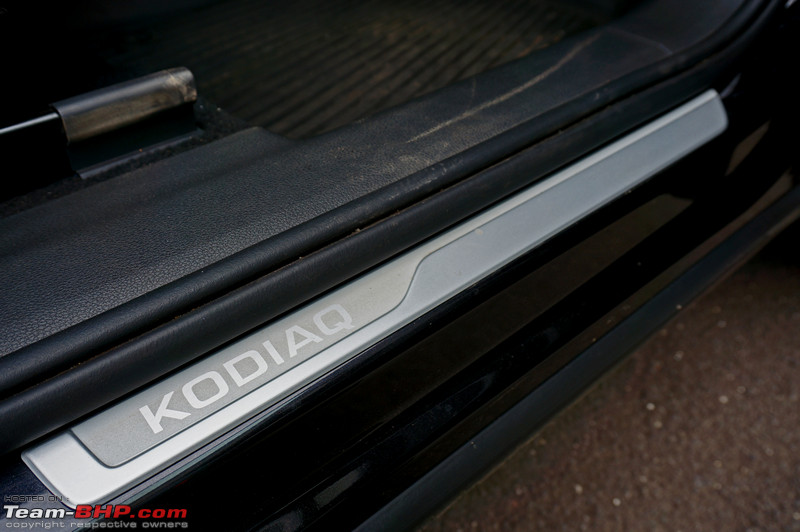 The seats are wrapped in stone beige leather upholstery. The firmness is on point and there is good bolstering on the side. They aren't ventilated like the Superb's, but offer very good support overall. The underthigh support also seemed adequate for my height (5'10"): 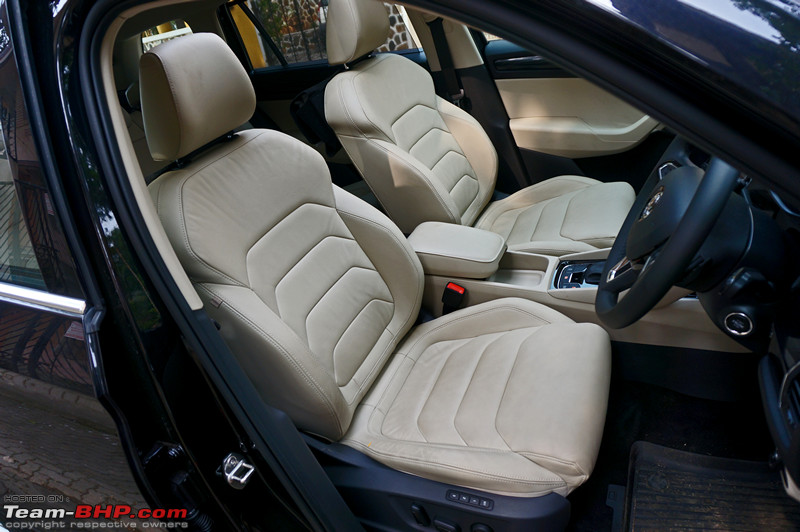 12-way electrically adjustable front seats with 3 memory settings even for the passenger (including adjustable lumbar support for the passenger):  The front seats have a healthy fore & aft travel range: 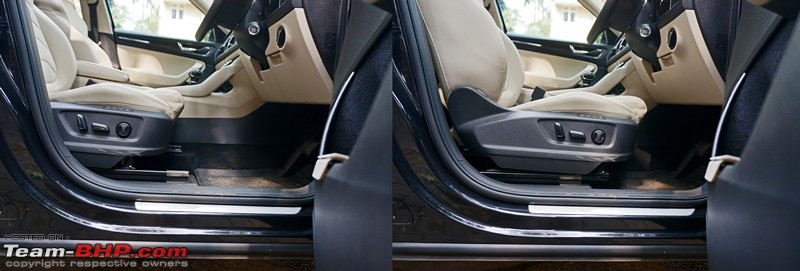 The seat height adjustment also has a good range. Finding your perfect driving position is quite easy with this level of adjustments:  A close look at the leather used on the seats. Also check out the side bolstering on them, helps in keeping you in place while driving: 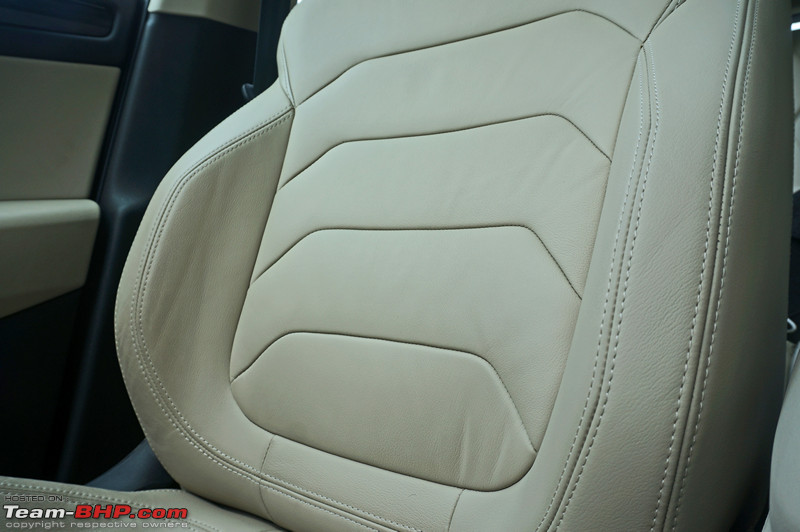 The headrests do not have fore and aft adjustment like the Tiguan, yet these are very usable:  The central armrest is wide and partially covers the storage space below it. You can slide it forward to completely cover the storage:  The leather wrapped armrest can also be adjusted for height:  The seatbelts are height adjustable:  The driver gets a grab handle as well: 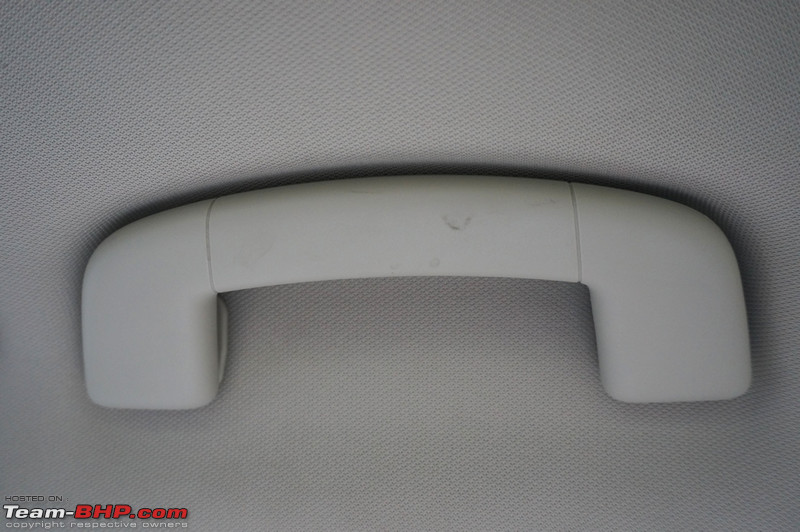 The dead pedal is decently sized and comfortably angled. The brake and accelerator pedals are well spaced. We wish that Skoda had gone for the organ-type accelerator which is ergonomically friendlier (related thread). Also note the all-weather floor mats which are available as an accessory:  The ORVMs are tall, but I wish they were wider. These are heated and have auto-dimming (anti-glare) and memory features:  The super-classy frameless auto-dimming IRVM is wide enough to cover the rear windshield. Rear headrests and thick D-pillars do hamper visibility:  The auto-dimming sensor is placed behind the IRVM. The feature is on by default: 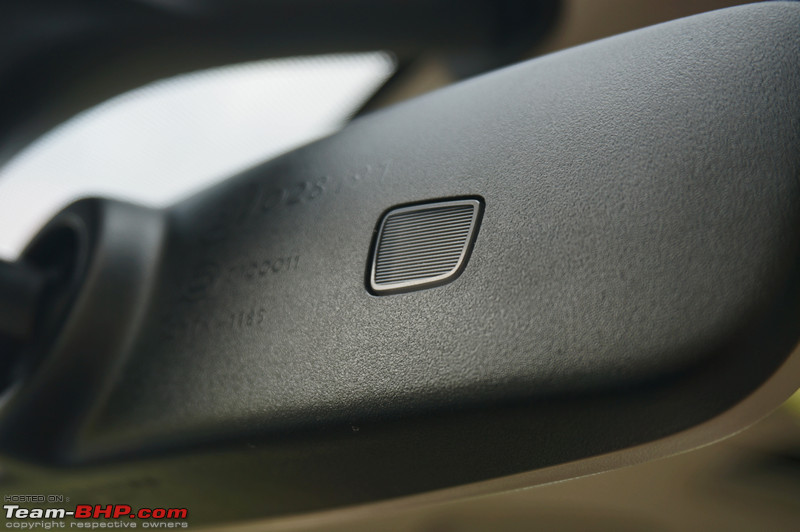 The rearward visibility isn't that great. The thick D-pillars and headrests obstruct your view, and if there are passengers on the rear seats, you will be heavily depending on the reversing camera to manoeuvre this SUV:  Quite a few buttons spread around the center fascia, but overall, it's very neat with subtle chrome touches making it look classy:  The tall central air-con vents are placed on either side of the 8-inch infotainment touchscreen. Air flow from the vertical air vents can be controlled by the knurled knobs placed below:  The Kodiaq gets a 3-zone climate control system. The system performed well in keeping the temperature at optimal levels. The buttons and knobs used are very similar to the ones seen on the Octavia. The blower is controlled by the middle knob, and is silent at levels 1 & 2, audible at 3 & 4, loud at 5 & 6 but very loud at 7. The lowest temperature that the system goes to is 16 degrees centigrade before hitting LO, while the highest it can touch is 29.5 degrees centigrade before hitting HI; increments are in 0.5 degree levels. Pressing the 'Sync' button gets the temperature of the passenger side to the same level as that of the driver. They both can be controlled simultaneously by using the driver's side temperature knob. On turning the passenger side knob, the sync function is automatically disengaged & both get their own temperature zone. The blank on the middle knob is actually for windscreen heating on the international variant. Also, the two blanks on the top line are for the ventilated seat controls (missing in the Indian car). Trivia: the in-car temperature sensor has been placed in the center of the middle knob:  A look at all the buttons at night. The park assist and parking sensor buttons are placed at the bottom, along with the hazard light and central locking buttons:  With the air-con in 'Auto' mode, some air is also directed through the front windshield defogger vents. Unfortunately, you will be seeing this a lot while driving around in 'Auto' mode:  Shiny black cover with a chrome handle. Push it upwards...  ...and you will see a cubbyhole big enough to easily gulp your smartphone. There is also a 12V power socket, Aux-in jack & a USB port to connect your smartphone:  The cubbyhole is illuminated and gets a rubber mat as well. The 12V socket is lit on the circumference, but the Aux and USB inputs aren't: 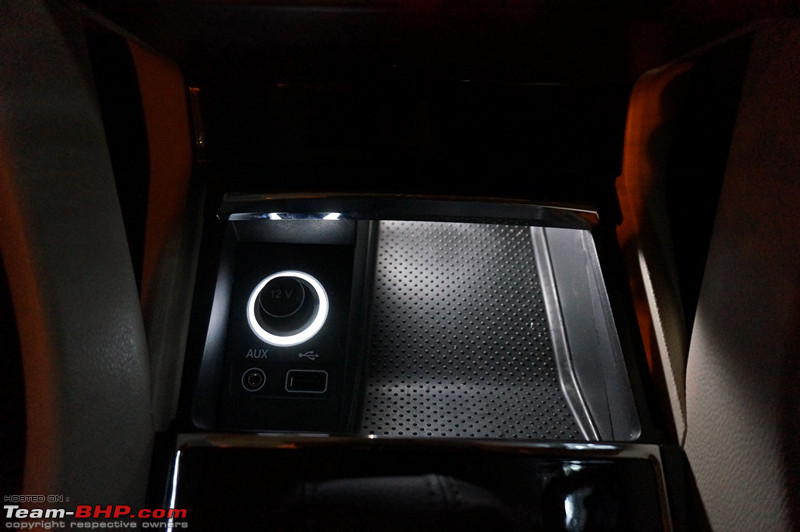 The center console gets a recess which can work like a grab handle, very similar to the ones seen on some of the Range Rover cars (reference image):  The gear lever is ergonomically placed and is chunky to hold. The base has a piano black finish and the electronic parking brake along with drive mode select, auto brake and traction control buttons are placed ahead of it: 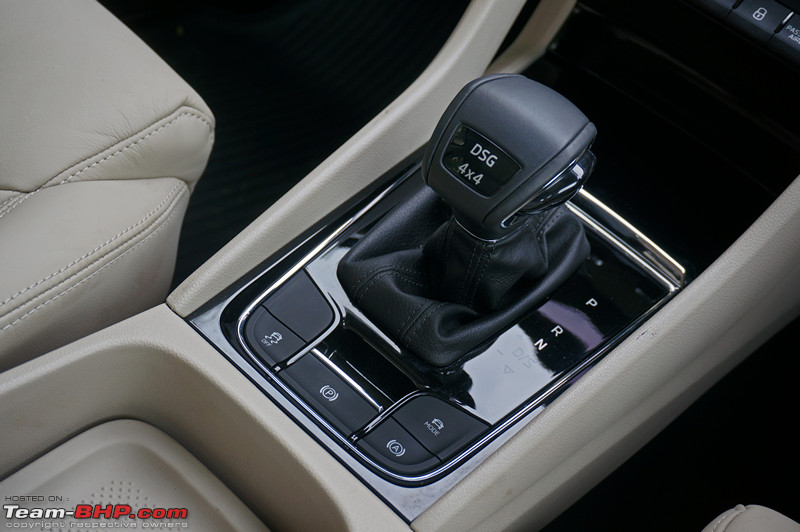 The partially open center armrest storage area gets this multipurpose base which has 2 sides. One being totally flat (left picture) and the other has 2 cup holders, a round slot to hold the 12V socket cover, slot to hold the vehicle key, and slots to place 2 coins and a card. The base can be completely removed as well if you want to increase the storage area: 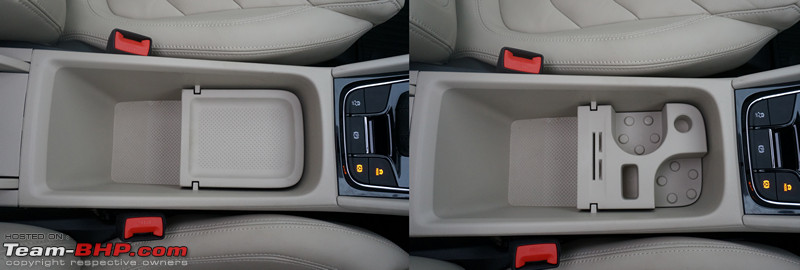 The passenger side footwell gets a net for storing miscellaneous stuff:  The front footwells are illuminated. You can control the brightness of the illumination as well: 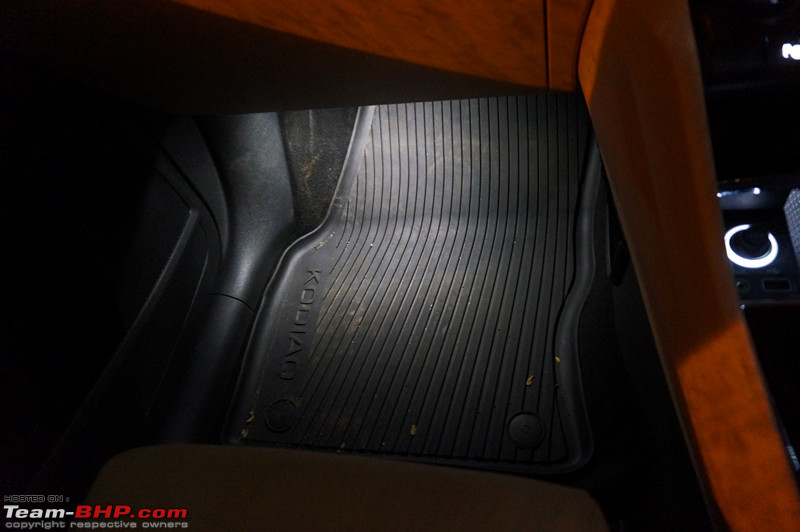 A closer look at the dashboard's black veneered finish: 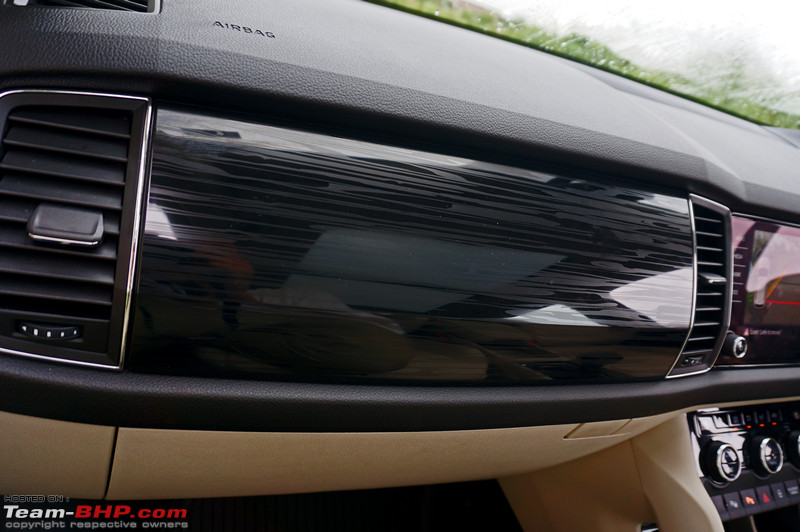 This doubles up as a storage compartment on the upper dashboard: 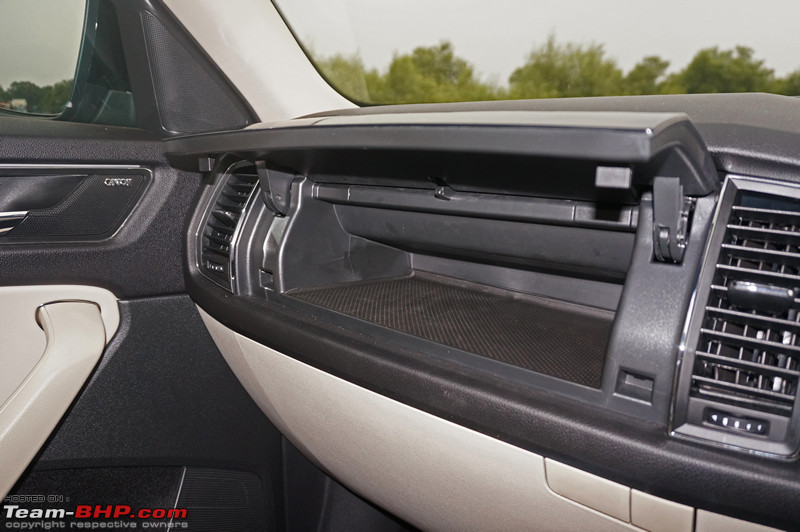 Below, you have the glovebox which is illuminated and gets a felt lining. Though the size of the cover is big, you will be slightly disappointed by the actual available space in the glovebox: 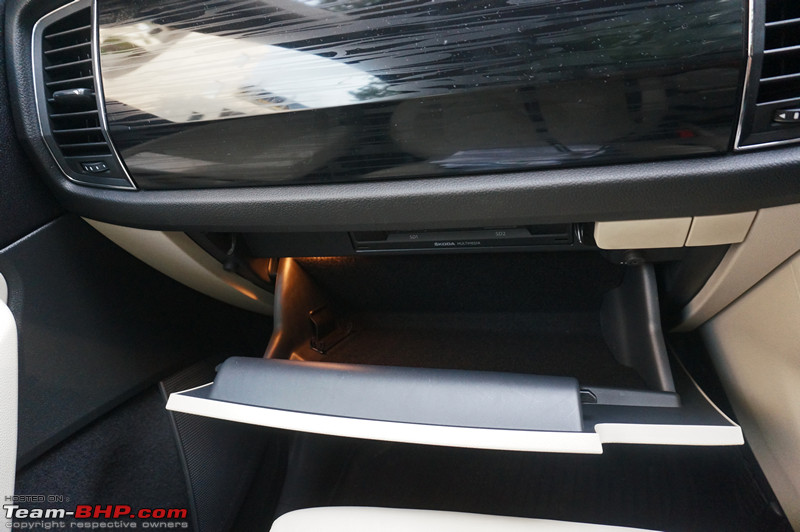 It is cooled...  ...and has 2 SD card slots. The additional slot is for navigation. The top-end trims of the international Kodiaq come equipped with a Columbus infotainment system which has a CD/DVD player. The mid variants get an Amundsen infotainment system which is also the one that is available on the Indian Kodiaq. The Amundsen system doesn’t get a CD/DVD player and hence that area is a blank on this system: 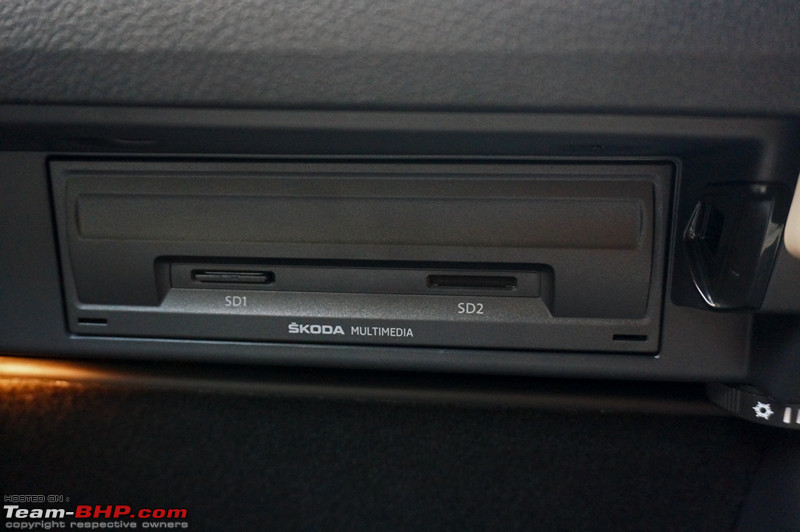 Look closely and you will also spot a card and pen holder inside the glovebox:  Sunvisors are robust - both sides get a vanity mirror with illumination. As soon as you slide open the cover, the light turns on automatically. Clip for holding parking / toll slips too: 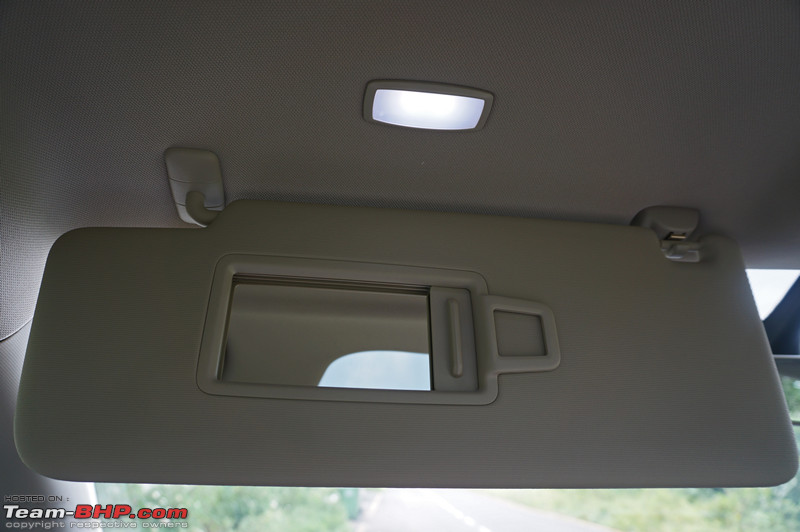 Sunroof & cabin light controls are lifted from the Skoda Superb. Cabin uses white LEDs all round. There's a button here for the rear cabin lamp as well. Bluetooth mic is integrated into this console. The two buttons at the top are used to open / shut the sunroof blind: 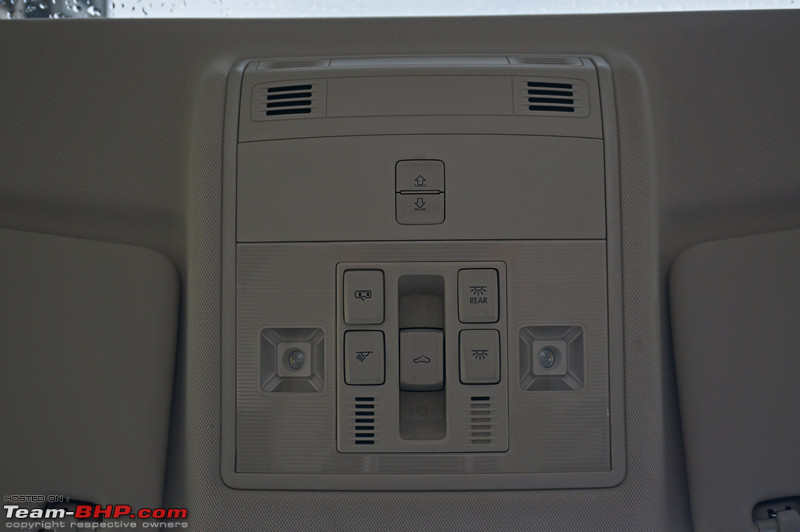 These are the security system's interior motion detectors: 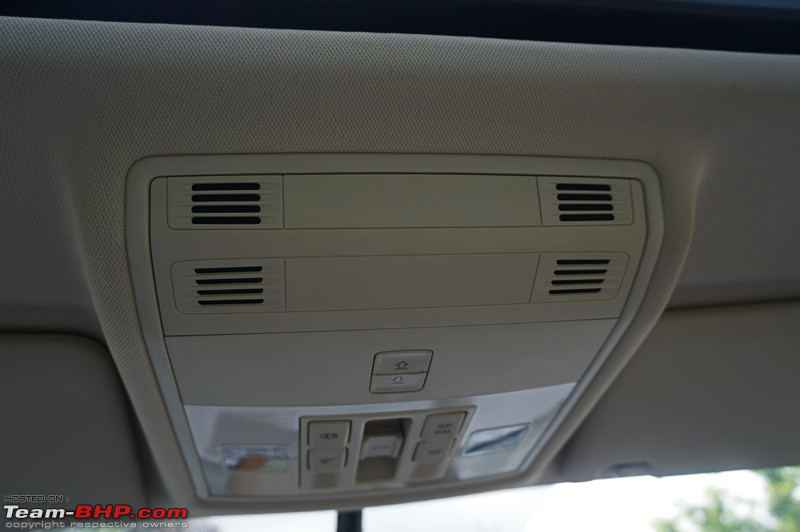 The Kodiaq gets a total of 9 airbags: 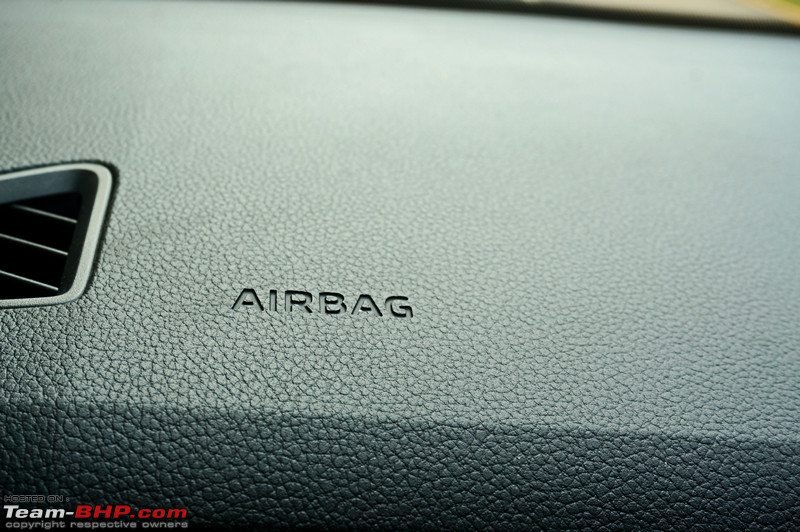 These include the curtain airbags... 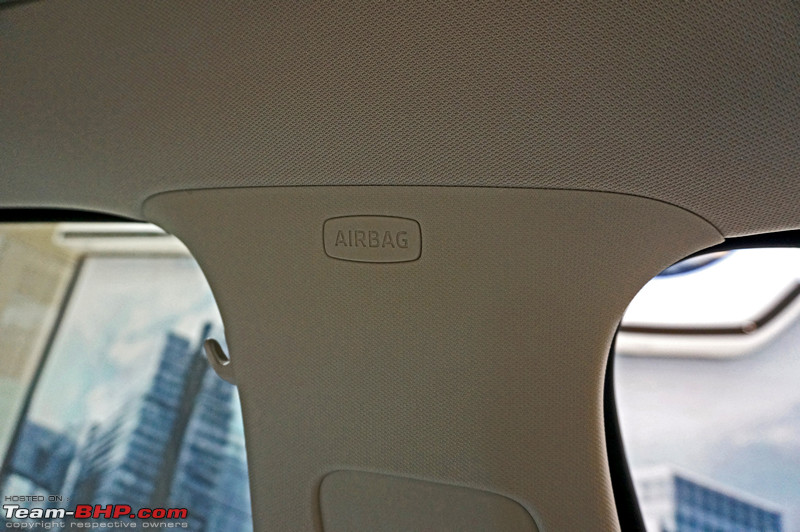 ...and even a knee airbag: 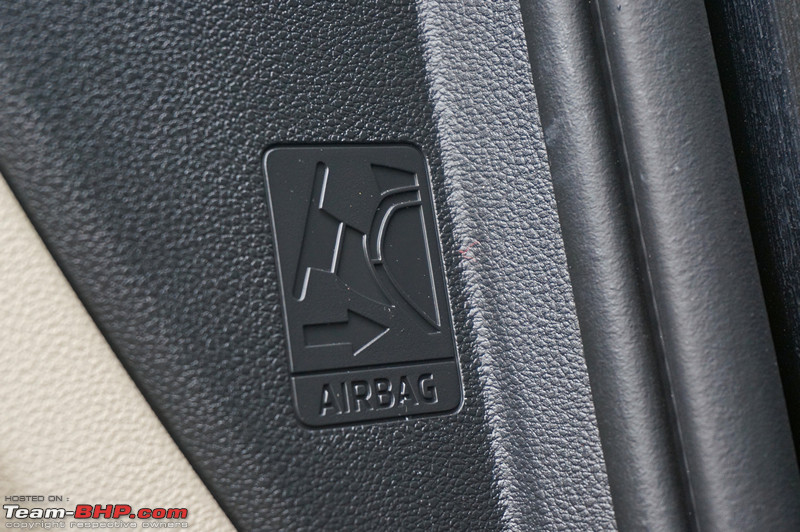 The Kodiaq has received a 5-star Euro NCAP safety rating (detailed report):  You can disable the front passenger's airbag from the side of the dashboard. You shouldn’t though – children should always be placed on the rear seat: 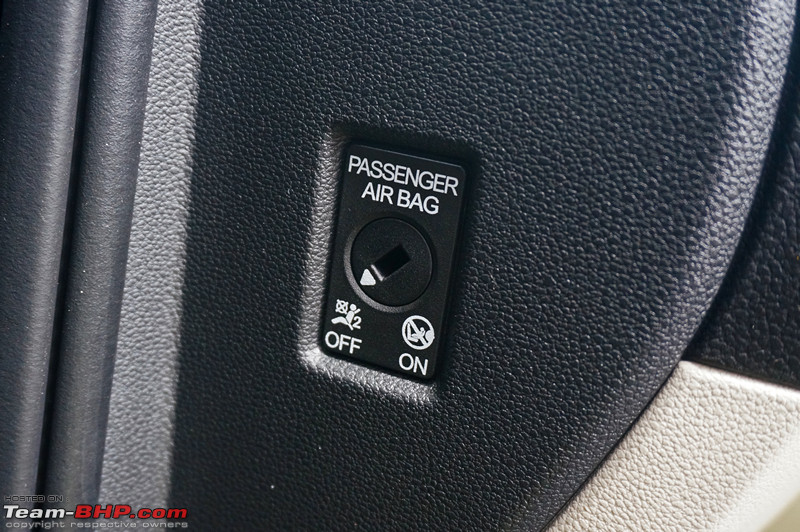 The Panoramic sunroof is huge, and plays a vital role in keeping the cabin bright. It also helps in making the cabin feel airy: 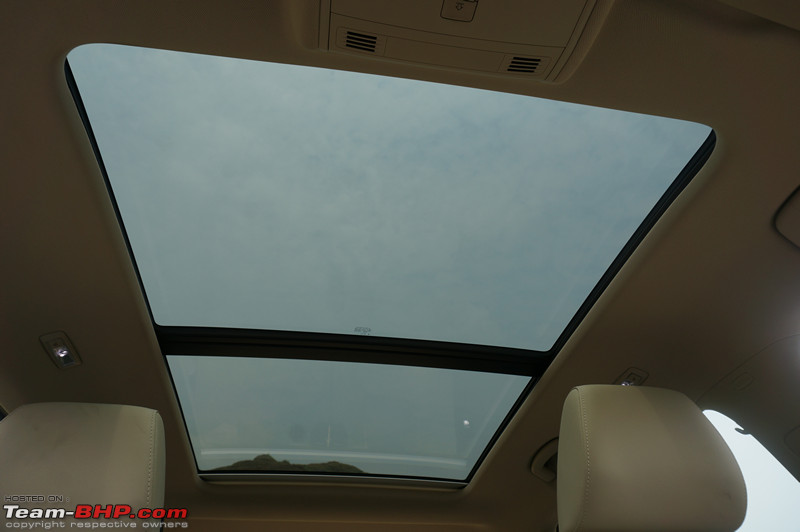 Sunroof opens outwards and goes a long way back. Looks ugly from the outside: 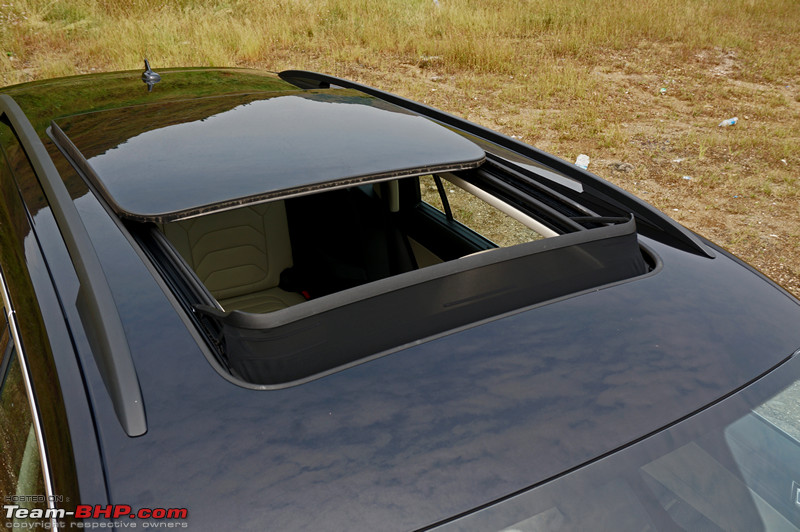 Last edited by GTO : 27th December 2017 at 11:44. |
| |  (38)
Thanks (38)
Thanks
|
| The following 38 BHPians Thank Omkar for this useful post: | Aditya, akshay81, CarguyNish, cn.vishnu, dailydriver, deetjohn, Dr.Vikas, F2005, GTO, InControl, kbishwa, lemedico, libranof1987, N33raj, noopster, npawan29, NPV, Obi-Wan, pankaj_sachdeva, parsh, phoenixash, PrasunBannerjee, RaghuVis, Rajeevraj, RavenAvi, roby_dk, sandeepsarma, Simat, sparky@home, suhaas307, sunny29584, supertinu, Turbanator, vb-saan, VeluM, Vid6639, viXit, zavegur |
| | #5 |
| Team-BHP Support  Join Date: Apr 2016 Location: Mumbai
Posts: 2,998
Thanked: 29,641 Times
| Interior - Rear The rear doors also open and close in a three-stage action. They open wide enough and getting in & out of the car doesn't take much of an effort, again thanks to the Kodiaq's lower height:  The gap in between the B-pillars and the seat base is wide, which means elder folk won't have a problem getting in or stepping out. Even the door sills aren't too wide aiding ingress / egress. Note the smaller 'Kodiaq' branded scuff plates:  The long rear doors follow the same colour scheme as the rest of the cabin. The top part of the doors gets the black veneer trim along with tweeters and the ambient LED strip. What's shocking is that the rear doors don't have the same soft touch plastics as the front!!! The rear passengers get hard plastics (except for the soft leather on the armrest section):  Even the rear doors get those clever edge protectors. Here's a close look at them in action. Simple yet effective: 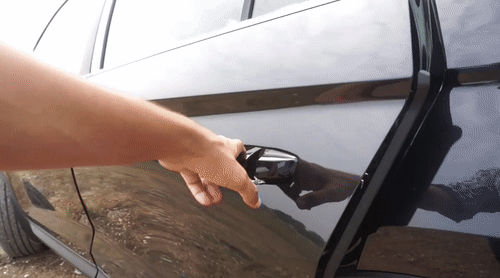 Rear door pockets are good for 1L bottles and some other stuff. Just like the front door pockets, these are also felt lined. Very premium:  The rear seat splits 40:20:40. The rear bench can accommodate 3 people with ease due to the width of the Kodiaq. The base gets contours to hold you in place. The middle seat passenger gets a slightly shorter seat base and a flat seatback, but there is a middle headrest and a 3-point seatbelt: 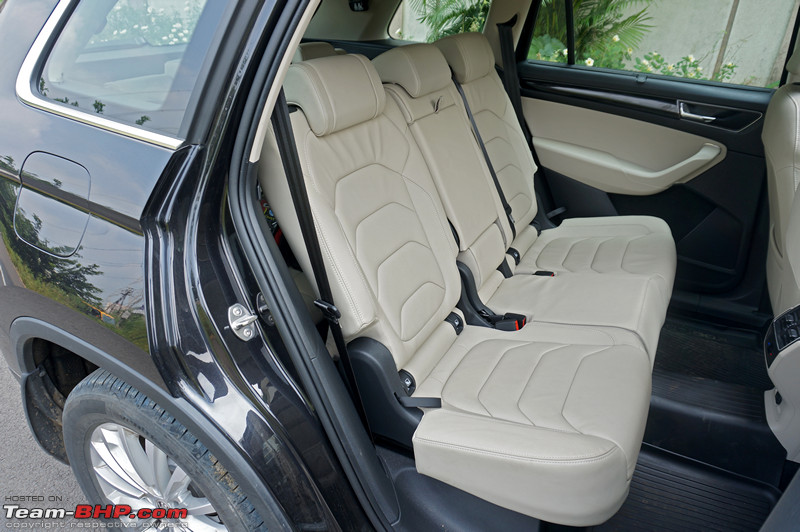 The headrests are wide and can be adjusted in 2 positions above the lowermost one. But they also have a party trick. The sides of the headrest fold outwards providing perfect support to rest your head on. Rear passengers falling asleep no longer have to worry about getting intimate with their co-passenger’s shoulder. Skoda calls this as a 'Power Nap' package. Part of the simply clever touches by Skoda:  Overall legroom is more than adequate for tall people as well:  A look at the maximum and minimum legroom:  At 5’10”, I wasn’t uncomfortable even with the seat pushed all the way back. Seated behind my driving position, I had a good 4 inches of knee room. Note that the seatback is scooped to increase the available space:  Both sides of the second-row seat (in the 60:40 split) have fore & aft adjustment:  The travel range for this adjustment is over 18 cm:  Shown here is the difference between the 2 positions: 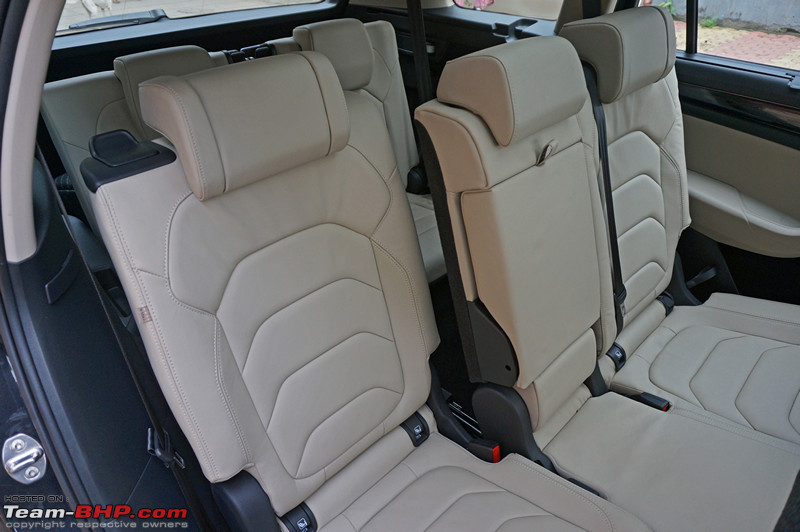 To recline or fold the seatback forward, you have to pull this strap. It is particularly difficult for a person sitting on the seat to try & recline it. A conventional lever on the side would've been preferred like the one in the Tucson:  The side bolstering isn’t as prominent as the front seats, but still offers reasonable support. The door armrest is at a perfect height for me (5’10”). The under-thigh support is adequate, though I wish it was a little more considering this is going to be a chauffeur driven car for many owners. The seat height (from the floor) is not at a high set position like some SUVs. It's on the lower side, yet not so low down either that it results in a knee-up position:  The centre armrest is wide, and 2 people can easily use it without their elbows brushing each other. The height is again on point for me, although shorter passengers might find it slightly on the higher side:  The seat bench can be reclined as well and many of the sahibs out there would prefer it this way. Very relaxed:  A look at the difference in the 2 recline positions:  The center armrest as mentioned earlier is wide but gets the same cupholders as the Octavia. Skoda should have carried forward the foldable cupholders from the Superb (reference image):  With the selective folding, you can access the boot (if 3rd row is folded) from the 2nd row seats. You can also use this to carry long items (e.g. skis):  The seatbelt buckles are nicely tucked away when not in use. Check out the felt lining on the inside of the buckle to prevent the 2 buckles from rattling:  The seatbelts are mounted on the C-pillar. Note the curtain airbag on this pillar: 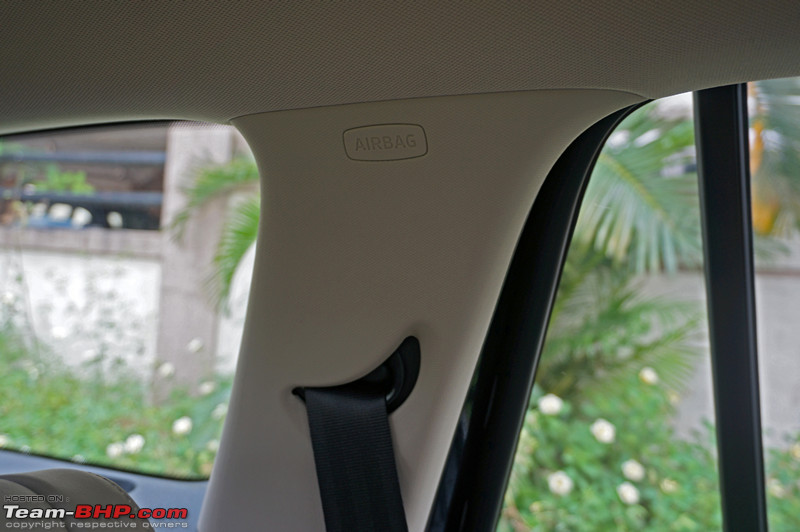 Clips are in place to neatly tuck the seatbelt so that it doesn't come in the way when folding down the seats:  Forward visibility (for rear passengers) is obstructed by these big front headrests:  Even with the rising window line, the glass area is satisfactory thanks to the large greenhouse:  A much-needed manual sunshade to provide protection against the scorching sun:  The rear windows roll all the way down:  Seatback pockets for the miscellaneous stuff on both front seats:  Grab handles are damped and of good quality. Both the rear ones get a coat hook:  LED reading lamps on both sides are placed next to the grab handles:  Nifty coat / bag hooks on the B-pillars: 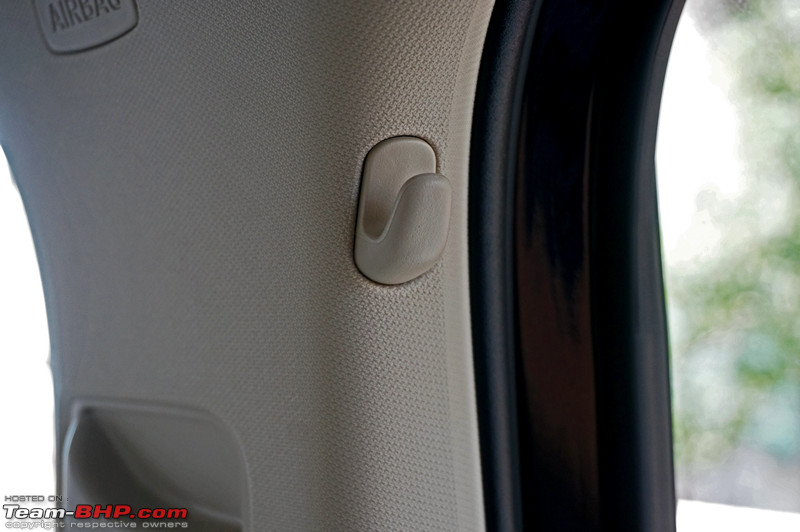 The rear A/C vents get a manual volume control in between. The temperature is displayed at the bottom and can be set individually for the rear thanks to the 3-zone climate control system. The dummy buttons on the side of the temperature control buttons are for the ventilated seat function found on the international variant. Unlike other SUVs, there are no A/C vents found on the roof or the B-pillars:  A 12V power outlet is also provided just below the A/C vents:  Air vents for the rear passengers' feet as well as ambient lighting...  ... to illuminate the rear footwells at night:  Even though there is ample legroom and width for a third passenger, a tall and wide floor hump will make the middle passenger uncomfortable. He will have to place his feet on either side of the hump:  Both sides get ISOFIX child-seat anchors:  The rear seats fold down flat. This is also how you access the third row of seats:  Top tether for the child seats are placed behind the rear seats:  The rear passengers get side airbags as well:  Last edited by GTO : 27th December 2017 at 13:51. |
| |  (33)
Thanks (33)
Thanks
|
| The following 33 BHPians Thank Omkar for this useful post: | Aditya, cn.vishnu, Col Mehta, dailydriver, deetjohn, DrANTO, F2005, GTO, iliketurtles, InControl, JTM, Leoshashi, libranof1987, N33raj, NPV, Obi-Wan, pankaj_sachdeva, parsh, phoenixash, RaghuVis, Rajeevraj, RavenAvi, sandeepsarma, SDP, Shome, Simat, sparky@home, suhaas307, sunny29584, Varun_HexaGuy, vb-saan, VeluM, Vik0728 |
| | #6 |
| Team-BHP Support  Join Date: Apr 2016 Location: Mumbai
Posts: 2,998
Thanked: 29,641 Times
| Interior - 3rd Row The 3rd row of seats is a crucial advantage that the Kodiaq has over competitors like the Tiguan & Tucson, even though it's suitable for kids only (still, a 5+2 is better than just 5). Accessing the third row of seats is always tricky and each manufacturer has their own way. Getting into the last row of the Kodiaq isn't one of the easy ones though. Pull this latch to move the middle row seat forward and fold it partially. This can be used by the passengers seated in the third row while getting out too:  Pulling the latch folds the seats to 45 degrees and you can slide it forward at the same time. The seats don't tumble forward like they do in the Fortuner. As you can see, the opening with the seat all the way forward is quite narrow and requires a couple of yoga positions to get in:  Another way is to just fold the seats flat down and move them forward using the lever on the bottom:  The seats are not as soft as the front ones, but aren't uncomfortably hard either:  The two seats get adjustable headrests as well. They are big and...  ... have 2 positions of adjustment. The top position raises the headrest almost till the roof! 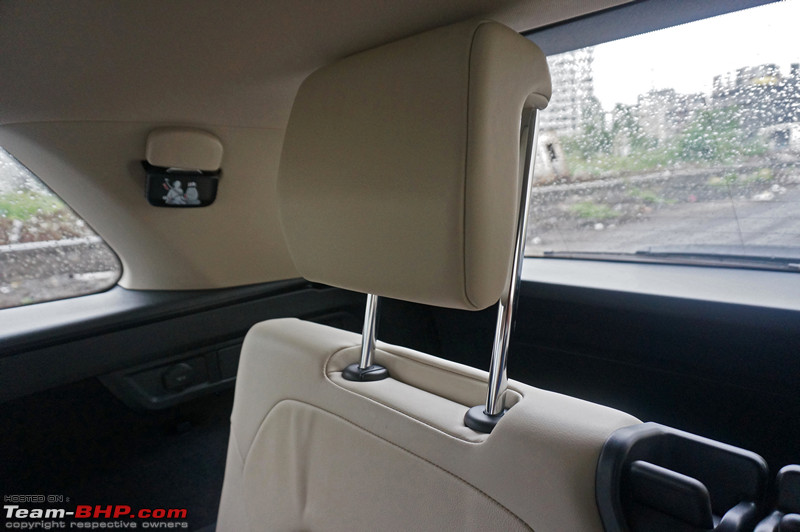 Remember when I said that the last row is best suited for kids? This is the reason why. The headroom for me (5'10") was barely an inch and with the middle row of seats all the way pushed back, the knee room was non-existent. There's not much to talk about underthigh support as there isn't any. The seatback angle is also a little too upright. These seats are appropriate for kids, or over short journeys for the shortest passengers in the family:  You can free up some legroom by moving the middle row seats forward and sacrificing their legroom. Here is a look at the maximum and minimum legroom for the third row of passengers:  The quarter glass brings in a decent amount of light, so you don't feel claustrophobic:  The right-side passenger gets a slot to hold a mobile phone...  ... while the left-side passenger gets a cupholder and a small cubbyhole:  The last row also gets an LED lamp like the second row:  3-point seatbelts even for the third row passengers  : : A look at the roofline shows you the total glass area which is a major contributor in keeping the cabin bright and airy:  The boot opening isn't that high, and there's hardly any loading lip - allowing you to just slide in the luggage after placing it on the lip. Also note the honeycomb plastic trim in place to avoid damage to the body coloured bumper:  Even with the third row of seats up, there is a good amount of boot space (almost like a large hatchback):  Pull these flaps to fold down the third row of seats manually. The Indian spec doesn't get the 'easy folding' third row seats: 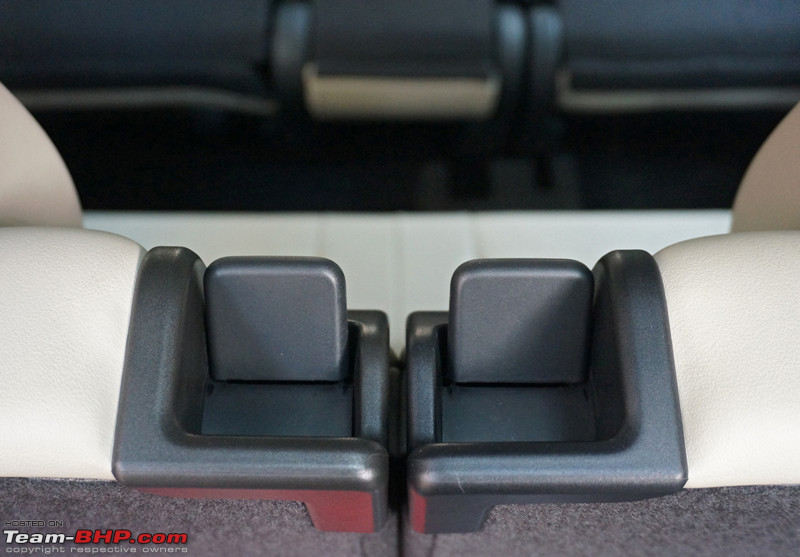 Although, if the middle row of seats is at the rearmost position, the third row won't fold down flat:  You need to move the middle row of seats ahead or recline them forwards to allow the third row seatback to fold down completely flat, giving you a boot space of 630 litres:  The middle row of seats can be further folded in 40:20:40 ratio to increase the boot space to a humongous 2,005 litres:  A look at the virtual boot pedal operation. Simply walk up to the car, swing your foot under the bumper and the bootlid opens! The sensor detects the swinging foot (provided that the key is within range) and opens the boot after a second. However, the system is not that straightforward; if the gap between your locking the car and coming back to open the boot is too short, it has trouble functioning (no such issue if the gap is 10 minutes or so): Alternatively, you can open the boot using the key fob, the boot release button on the driver's door or the button on the tailgate. There's an alarm when the boot is opened using the key and the driver door boot release button. For parking areas where the ceiling height is low (like low basement parking spots), you can program the boot to open only until a particular height. The cool feature is that this is a memory function, and the next time you open the boot, it will open to that particular position only:  A look at the button that closes the tailgate automatically. A thing to note is that the warning beep for closing is played only when you use the key fob and not this button (nice attention to detail):  The tailgate gets a full plastic cover with no bits exposed. A clean design altogether:  A retractable bag hook on the right...  ...and a 12 V power outlet as well. The blank next to the power outlet is for the rear seat fold down tab on the international variant which is similar to the one seen on the Tiguan (reference image). Seen below is one of the fasteners for the boot nets:  LED boot lamps are placed on the D-pillars:  Storage spaces on either side. The one on the left has the boot nets and the one on the right has the first aid kit:  The covering lid of the storage space also carries the honeycomb design pattern:  Another simply clever addition from Skoda. The boot lamp seen here doubles up as an LED torch. You can remove the light by simply sliding it out of its position. It is charged whenever it's placed back there:  It even has a magnetic base! Stick it to the fender while changing the tyre at night!!!  A look at the grab handle to lift up the boot floor. Also note how the boot floor and the loading lip are almost at the same height:  The boot floor is thick and of nice quality. Stored below is the luggage cover. You can lock the boot floor in this position...  ...by sliding it into this groove:  The retractable luggage screen can be used to cover the cargo in the boot. Do not place anything on top as it will get thrown around easily:  Just press the front area near the handle to send the luggage screen back into the cover:  These straps behind the third row seats can be used to pull them back into position from the boot. With the seats still folded, pull these vertically upwards...  ... to raise the base of the seats and access the spare tyre:  You don't have to put too much effort, as the base is raised with the help of pneumatic struts:  The Canton subwoofer is located in the spare wheel. Something similar to an Audi Q3 (reference image):  Tools are neatly stacked in Styrofoam cut-outs below the spare tyre: 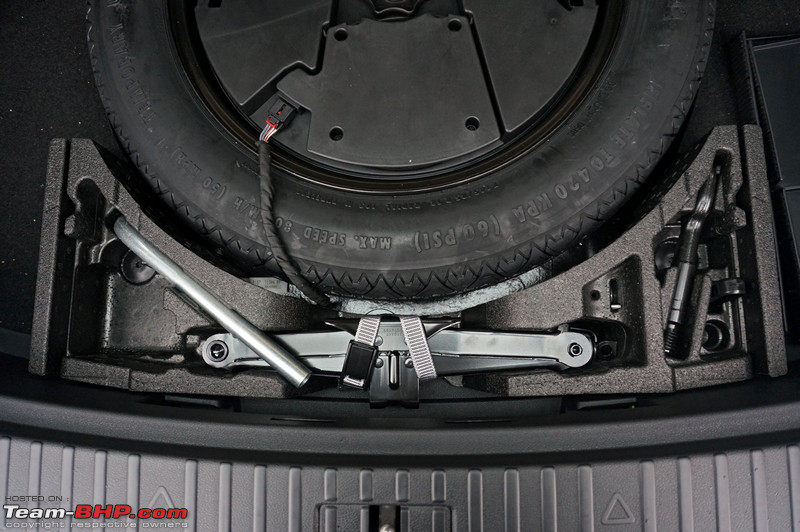 Spare wheel is not an alloy, but a space saver 18" steel rim with a 145/85 tyre wrapped around it. You will have to drive at slow speeds whenever using the spare. We wish that the Germans start providing full-size alloy wheel spares:  Cargo tie-down hooks are placed on the C-pillars...  ... and D-pillars:  There are fasteners placed in the boot area for the cargo nets:  Here is an example of how you can fix the cargo nets:  Square cargo boxes can be held in place with these packing plates which have Velcro strips at the bottom (which fix them to the boot floor). Skoda calls them the 'universal fixing element' and these were available as an accessory in the Superb:  Last edited by GTO : 27th December 2017 at 11:42. |
| |  (40)
Thanks (40)
Thanks
|
| The following 40 BHPians Thank Omkar for this useful post: | Aditya, adroit_91, akshay81, amrutmhatre90, CarguyNish, CEF_Beasts, cn.vishnu, deetjohn, Dr.Vikas, F2005, GTO, InControl, JTM, kbishwa, lemedico, libranof1987, N33raj, noopster, NPV, pankaj_sachdeva, parsh, phoenixash, pulsar56, RaghuVis, Rajeevraj, RavenAvi, sandeepsarma, SDP, Simat, suhaas307, sunny29584, timuseravan, uday.ere, Varun_HexaGuy, vb-saan, VeluM, Vid6639, Vik0728, Vmv, wheelguy |
| | #7 |
| Team-BHP Support  Join Date: Apr 2016 Location: Mumbai
Posts: 2,998
Thanked: 29,641 Times
| In-Car Entertainment The Kodiaq comes equipped with Skoda's Amundsen infotainment system. The 8-inch capacitive touchscreen is similar to the one seen on the Octavia, with touch sensitive buttons on either side of the screen (instead of physical buttons). I personally felt that the physical buttons in the Superb had better feedback than these. Looks like Skoda and VW are moving towards capacitive buttons on all cars. The inbuilt Amundsen navigation system is also quite sophisticated and easy to use. In terms of connectivity, you get Bluetooth, USB, Aux-in and SD card connectivity. You also have MirrorLink, Apple CarPlay and Android Auto. SQ is taken care of by a 575W Canton 10 speaker system including a subwoofer and a center channel. A cool party trick is the voice enhancement feature. This feature transmits the voice of the front passengers to the rear passengers through all the speakers!! You can set the sensitivity as well. This was really unnerving when we experienced it the first time. It felt like the Kodiaq cabin was so large that there was an echo as we could hear our voice get amplified at the rear of the cabin. Once you get used to it, you'll enjoy it. No need to speak up to get your point across  . . The touchscreen is very easy to operate, and the response time is also fast. Bring your finger close to the screen and a tab pops up displaying the function of those buttons. The feedback is very much like a smartphone. Visibility under direct sunlight is average, but overall the system is very good to use:  The 10-speaker Canton sound system is awesome! The system has a power output of 575 watts. Although this may seem like a tweeter at first glance, it's a blank. The Canton branding has been added just as an aesthetic element and...  ... the front tweeters are actually placed above the doorpad near the ORVM housing:  The rear tweeters are placed near the door handle:  All doors get a single mid-bass speaker at the bottom (the Superb has an additional mid-bass on the front doors):  The dashboard gets a 25W central speaker and...  ... the subwoofer is placed in the boot (in the spare wheel). Overall sound quality is amazing, even though it is 2 speakers less than the Superb L&K (610W):  You are welcomed by the Skoda logo on start-up:  The selected colour of the ambient lighting is carried forward as the system's background colour. In this case, green. The main menu is well laid out and you move through the options by sliding left or right. Do note the lines at the bottom of the screen, which follow the design theme seen inside the headlamps:  You get Canton optimized equalizer options, along with the usual equaliser settings as well as preset profiles:  The system even does 'Time Alignment' letting you optimise the sound for the driver. The sound doesn't clip at high volumes and the output remains clear. Music lovers won't be disappointed with the system:  There are multiple sources to choose from:  The radio screen is also well laid out with big buttons for the radio presets that can be programmed:  Pressing the voice control button on the steering wheel opens up the menu guide for various functions:  Enjoy images and videos via the USB input:  There's an option to check your greenscore from time to time. The greener the leaf, the more economically you have been driving. The green colouring fades if you aren't economical. The graphs also represent the driving style. Higher the bars, the more economical you have been. Each bar is a 5-second step and you can see your performance over the past 3 minutes. The green score and average fuel consumption are displayed on the right. Tap the score tab and...  ...you can view consumption and green score over the last 30 minutes of driving time:  Vehicle stats under different conditions. The 'convenience consumers' tab displays electrical accessories that are major contributors to fuel consumption in the car. Displayed here is the air conditioning. On international variant, this includes seat heating, steering wheel heater etc.:  The climate control system can be adjusted from the infotainment system as well as the physical buttons. You can even lock the temperature of the rear zone. Only if you unlock it, can the rear passengers change it. Change the climate control setting by using the buttons, and the main area on the screen dims to show the changed temperature. A tab showing blower speed and current operation mode comes as an overlay. Touch on the 'Manual' tab to open the presetting options:  The Kodiaq gets air care climatronic control. If you don't know what it means, the system tells you exactly what it does! You can switch off the automatic air recirculation from the air conditioning settings. Unfortunately, there is no way to always keep air recirculating on in Auto mode. This means that when you pass by a foul smelling or highly polluted area, the system sometimes will let that odour / pollution enter the cabin. On the flip side, the auto mode will ensure that the cabin remains 'fresher':  10 colour options for ambient lighting. You can even set the brightness of the white light in the footwells:  Vehicle status tab shows important messages related to the car (here's one for the washer fluid):  Pairing your phone with the system is quite easy. The dialpad has big numerical icons. You can also view text messages and the call log once the phone has been synced:  While entering the address for navigation, the system shows a disclaimer telling you to enter the complete address:  The system keeps on learning the frequented routes that you take:  After entering the destination, you can have petrol stations, car parks and restaurants on the route displayed. If you want to change the layout of the navigation screen, there are multiple options available there as well (2D, 3D, day, night etc.). When you start the route guidance, the navigation shows you 3 options - Green is the most economical route, red is the fastest route and orange is the shortest route. The directions are concise and displayed nicely. Tap on 'My dests' to store your current position, set home address and other route + destination options:  Go to settings and there are so many route options! You can have the optimum route by telling the system to avoid certain road conditions:  Very sharp display. There are colour-coded adaptive guidelines. If the object is too close, the car display on the left pops up showing the distance bars around the car. There are different camera views which you can choose from:  Pressing the Park pilot button on the center console shows this on the screen. It displays the steering wheel orientation depending on the gear you are in (reverse in this picture). On the move, if a pedestrian or biker comes too close, the car display pops up on the left of the screen with an auto prompt which is highly irritating in Indian traffic conditions. You can turn it off from the menu options & that's recommended as the system goes berserk in Indian traffic:  The Kodiaq has a plethora of system settings and you will spend a lot of time just skimming through the options. The volume settings include speed dependent volume adjustment which has 7 levels. It is best to use at 4 & 5, as after that it gets too sensitive. The system settings include various options for time, date, language, Bluetooth, WLAN etc. Different vehicle related settings like ESC, auto parking options, ambient lighting, wiper related settings, central locking etc. can be tuned. The automatic headlamp operation and coming home / leaving home functions can be switched off from the infotainment system. The FM and Bluetooth options are standard and easy to operate:  You can personalise your individual profile as per your preferences (useful when sharing the car with other family members). The navigation settings include the options which we saw earlier. Opening the advanced settings shows up more options. The country specific speed limits are displayed whenever you cross the international borders. You have the option of turning off the screen if there is no activity for 10 seconds. You can change what the MID should display and should not display from the infotainment screen too:  The infotainment system offers MirrorLink, Apple CarPlay and Android Auto connectivity:  Connectivity through USB for Android phones was easy:  The CarPlay display. Note the lack of navigation with Apple CarPlay (sucks because we love Google Maps):  You can view system related information...  ... as well as vehicle related information (including the VIN):  Thanks to the vast menu and options available, you are going to be seeing a lot of fingerprints on the screen as you play with it. Keep a microfiber cloth nearby if you have OCD to such stuff:  For the chauffeur-driven sahibs, Skoda has the 'Media Command' app for the operation of the infotainment system (shown here is an 8" iPad):  The Media Command app establishes connection through WLAN (it's a long, complicated process); the steps for connection are displayed on starting the app. The app allows you to move between Media and Navigation. You can have media display, navigation display or a combined display of media + navigation:  Since the navigation is connected to the infotainment system, the previous destinations can be accessed from the device. You can access media options which include radio and the different media sources. You can change the song which is being played on the system through a different phone via Bluetooth! You even have Balance / Fader settings in the app: 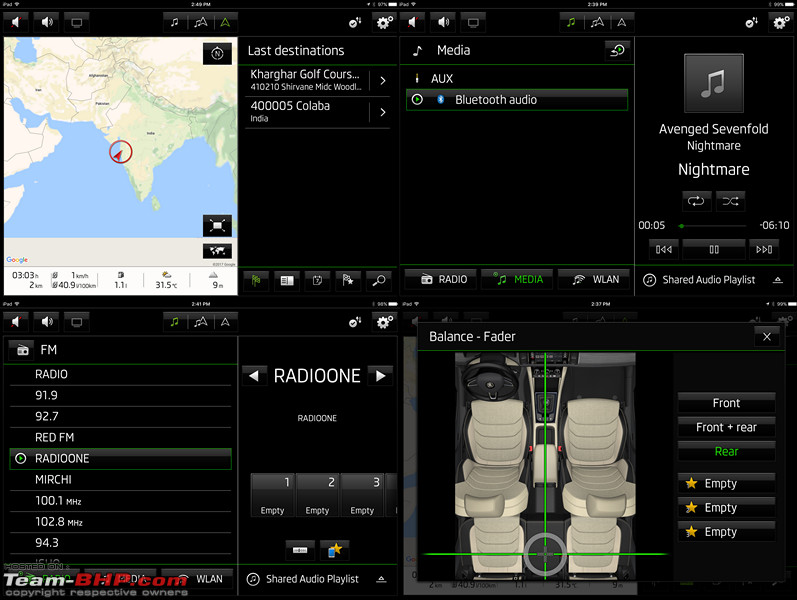 Coming to the app which many BHPians would be interested in, this is the Skoda OneApp. You can connect your phone through USB and pair via MirorLink or connect to the infotainment system's WiFi. Once you are connected with the car, you get all vehicle related information (service check, oil change etc.). You even get the trip related information like top speed, max rpm, average consumption, average speed etc. You can explore nearby places and even go through the records since you installed the app:  There is a car dashboard mode which shifts the screen to landscape mode and displays larger icons. If there are no problems with the car, the system will assure you that everything seems fine. The maintenance related info and all the information mentioned earlier can also be viewed in this mode. The Dashboard mode opens another tab which is more driver related. It displays the vehicle stats like the horsepower and torque when the car is running. Also seen at the bottom is the steering tilt (65% left tilt). See your records for the best 0-100 km/h timings. In dynamics, you can even see the G-force graph (on a 7-seater SUV  )! The system calculates the drive cost based on the diesel price you enter. Although Indian currency is not available in the list of currencies you can choose: )! The system calculates the drive cost based on the diesel price you enter. Although Indian currency is not available in the list of currencies you can choose: The system reminds you not to forget your smartphone when you open the driver's door. Super smart!  Last edited by GTO : 11th February 2018 at 19:40. |
| |  (29)
Thanks (29)
Thanks
|
| The following 29 BHPians Thank Omkar for this useful post: | Aditya, adroit_91, akshay81, CarguyNish, cn.vishnu, F2005, frankmehta, GTO, Hayek, kbishwa, lemedico, libranof1987, maddyg, N33raj, noopster, NPV, parsh, phoenixash, RaghuVis, Rajeevraj, RavenAvi, sangam_mm93, Simat, sunny29584, Varun_HexaGuy, vb-saan, VeluM, Vid6639, Vik0728 |
| | #8 |
| Team-BHP Support  Join Date: Apr 2016 Location: Mumbai
Posts: 2,998
Thanked: 29,641 Times
| Driving the 2.0L Diesel  The Kodiaq is powered by a 2.0L TDI diesel engine paired to a 7-speed DSG gearbox. There's an on-demand all-wheel-drive system as standard since there is only one variant on offer. The diesel engine is similar to the one in the Tiguan, albeit in a slightly different state of tune. This EA288-codenamed engine is seen in VW / Skoda cars based on the MQB platform which includes the Octavia, Superb and Tiguan. The motor is not part of the VW group's emission scandal, and Skoda has sadly gone with the lower state of tune than on the Superb. The diesel produces 148 BHP @ 3,500 - 4,000 rpm and 340 Nm @ 1,750 - 3,000 rpm in the Kodiaq. Straight away, these numbers look disappointing on paper for a 7-seater SUV weighing in at 1.8 tonnes. What's more is that these figures are lower than the cheaper Superb which makes 174 BHP and 340 Nm of torque. At the outset, we'll say that power delivery is 'adequate', but not special (as you'd expect after spending 40 big ones). The Kodiaq is being positioned as a Premium SUV offering with all the bells and whistles thrown in. The price point is well above the Superb's, hence the choice of a lower state of tune is simply inexplicable for a larger 7-seater SUV. It's not as if they don't have a higher state of tune available. Internationally, the Kodiaq is also offered with 188 BHP & 400 Nm torque. If they did bring that in, the Kodiaq could have given Audi, Mercedes and BMW a run for their money! Audi wouldn't have been too happy with this for sure. On the other hand, the performance of the Kodiaq with this 148 BHP tune in the real world is not bad at all, and not something a majority would complain of. Internationally, reports also claim that the 148 BHP tune is more driveable in urban environments with a more linear power delivery vs the higher tune which is known to be peaky. On the flip side, the 'adequate' power delivery could leave owners wanting when traveling with a full load of passengers & luggage on the highway. The Kodiaq has a kerb weight of 1,799 Kg. This is just 79 kilos more than the Tiguan. The power to weight ratio of the Kodiaq is 82 BHP / Ton, which is exactly the same as its 5-seater VW cousin, but also far lesser than the Superb's 111 BHP / Ton. These numbers just keep on reminding you why Skoda should have gone with the more powerful version of this engine. When you hear "7-speed DSG", the first thing that comes to mind are the horror stories of the Superb DSG. Luckily, this is not the same DQ200 gearbox. The Kodiaq (just like the Tiguan) gets a new 7-speed DSG codenamed 'DQ500'. And unlike the notorious DQ200 which was a dry clutch unit, this is a wet clutch box. This gearbox is supposedly more robust and reliable. Its maximum torque rating is also far higher at 600 Nm, which means there is a lot of headroom for this box (I can see the modification-friendly owners smiling). The gearbox also supports AWD as is the case with the Kodiaq. Though the numbers seem positive and the reliability is claimed to be better than the old dry clutch 7-speed DSG, the long-term ownership reports on Team-BHP will give a clearer idea. We have our fingers crossed. With your right foot on the brake pedal, press the awkwardly positioned start / stop button to wake up the engine. Thanks to the insulation levels, the NVH level inside the cabin is quite good. It's not dead silent, which means you can still hear the typical diesel thrum...albeit softly. At low revs, you will notice that the engine noise isn't that intrusive. It's only after the revv counter crosses 3,000 rpm that the engine note gets louder. Vibrations are kept in check even at high rpm. Let go of the brake pedal and the car crawls at a speed of 7 km/h. Start driving around and you will notice that the Kodiaq is reasonably peppy, but not lightning fast. Considering the weight that it's carrying, the Kodiaq is brisk on the move. You don't feel as if you are driving a 1.8 tonne SUV with only 148 horses under the hood. Driving on city roads is effortless and you really appreciate the smoothness of the DSG transmission. There is a hint of DSG lag once you press the accelerator till the large Kodiaq starts picking up pace, but it's barely noticeable thanks to the sharp throttle response. The engine responds immediately to the slightest tap on the accelerator pedal. Overall power delivery is linear, and the gearbox is eager to upshift when driving around in the city with a light foot. The DSG is smooth, and owners will appreciate the engine / gearbox combination in bumper to bumper traffic. The gearbox doesn't downshift too often in city conditions under light / medium throttle inputs as the car is capable of pulling away in most of these situations. The Kodiaq behaves very well as a city commuter as it's nowhere as big & unwieldy as the Fortuner & Endeavour. This Skoda does hide its bulk. While the steering and dynamics are key to this, it's the engine and gearbox response that really make all the difference. The Kodiaq truly shrinks in city traffic, making it a breeze to dart in between slower vehicles during urban commutes. For the times when you want to perform a quick overtaking manoeuvre, floor the accelerator and the gearbox drops down a gear (or two) to pull you away. This is a free revving engine and it hits the redline effortlessly when you kickdown a couple of gears. Sometimes though, there is a slight gap of a second between pressing the accelerator and the downshift happening. Downshifts aren't as quick as the upshifts in any DSG. Take the Kodiaq out on the open road and you will notice that it can be a terrific mile muncher. The SUV will do triple digit speeds without any complaints all day long. The engine revvs at merely 1,625 rpm when doing 100 km/h while 120 km/h is seen at 1,950 rpm in 7th gear. Though there is a slight diesel thrum heard in the cabin at 120 km/h, it's not intrusive at all. The car feels relaxed on the highway and overtaking is quite easy as well. As mentioned earlier, the gearbox doesn't hesitate to downshift. Say you are cruising at 80 km/h in D at 1,375 rpm, and you floor the accelerator. The gearbox drops down 3 gears to D4 and the needle bounces off the redline before upshifting. The consecutive shifts happen at ~4,000 rpm. The mid-range is strong and has enough torque for those quick overtaking manoeuvres. On the highway, the Kodiaq's performance is competent due to the swift gearbox and good driveability of the engine. The SUV is by no means slow and is actually a lot of fun to push on the open road. On single carriageways, it is effortless to overtake by just pulling out into the oncoming lane, letting the box kickdown a couple of gears and fly past slower traffic. In terms of overall performance, the Kodiaq will easily show the Endeavour 3.2 and Fortuner 2.8 a clean pair of heels. How? Despite the numbers on paper showing the lowest figures for the Skoda, the Kodiaq is 300+ kilos lighter. To top it off, the DSG is leagues ahead of the torque converter boxes found in those old school SUVs. That said, we still insist that the Indian Kodiaq should have gotten the higher state of tune as 40-lakh cars aren't about being just competent - they are about being 'special'. Out on the highway is where you feel that if Skoda had given the higher 188 BHP state of tune, it would have been something else. It would have made the Kodiaq really special and set it apart from not just the Endeavour or Fortuner, but even the larger Audi Q5, Mercedes GLC and Discovery Sport! Worth mentioning that while testing the car, we didn't fill the boot up or seat 7 people on board. Performance with that 450 - 500 kilos of additional weight might be just about adequate. Just like most VW DSG units, the Kodiaq's DSG gets an "S" mode which basically changes the shift points of the gearbox and makes gearshifts more aggressive. In S mode, the gearbox holds onto a gear longer and shifts down earlier, providing engine braking as well as remaining in the meat of the power band. "S" mode is definitely the more enjoyable mode to drive in & the one to choose when you're in a mood to have some fun. Apart from "S" mode, you can also use the tiptronic mode by moving the gear lever to the left. There are also paddle shifters on the steering wheel. The paddles and tiptronic work in "D" and "S" mode too. The gearbox holds its gears till the 5,000 rpm redline before upshifting on its own. The engine feels strong till 4,500 rpm, after which performance starts to taper off. Above 4,000 rpm, the engine also starts getting buzzy, so it's better to shift up at 4,000 and work the torque instead. Manual mode is useful when making those quick overtakes on the highways. Since the gearbox allows aggressive downshifts and revv matches nicely, using the paddle shifters is fun. While the Kodiaq's engine sound is controlled, wind noise entering the cabin is rather high. We had complained about the same in the Tiguan as well. Wind noise starts creeping in at 100 km/h and is clearly audible at 120 km/h. This is disappointing in such an expensive car. Like the Tiguan, the Kodiaq features different driving modes which change certain parameters of the engine, gearbox, steering, ESP, adaptive lights and air-con. This is apart from the gearbox's "S" mode. By using the "Mode" button on the center console, you can toggle through the 5 driving modes - Normal, Eco, Sport, Individual and Snow. While the Tiguan had a round dial to choose between the different modes, the Kodiaq uses just a single "Mode" button. There's no "Offroad" mode either (which the Tiguan had). • Normal mode: Your everyday driving mode. It's a good balance between economy & power. When in need of a boost for dashing through the gaps in traffic, move the gear lever to "S". • Eco mode: Engaging Eco mode drops down the performance of the air-con system. The climate control doesn't work as hard in this mode, though it still cools the cabin sufficiently. The throttle response is dulled - the difference is quite noticeable. Power delivery is also lazy, and the engine has this coasting feature which is activated only in Eco. Step off the accelerator pedal and the transmission disengages from the engine, with revvs falling below 1,000 rpm. If you touch the brakes, it engages the gearbox again to provide engine braking. Eco mode is usable for relaxed cruising on the highway or in bumper to bumper traffic. The mode has enough power on tap to move around, but for quick overtaking, you will have to use the Normal or Sport modes. • Sport mode: Throttle response is definitely sharper in Sport mode. There is a bigger difference in the throttle response of Normal and Sport modes, than there is between Normal and Eco modes. Even the engine is more responsive in Sport mode as the car seems to move far more briskly. This mode is very well suited for spirited driving, although driving around in the city can be a little unnerving in this mode as the throttle response is sharper and the transmission is always in the powerband. The steering weighs up in this mode and the cornering lights adjust more dynamically as well. • Individual mode: The driver can choose to adjust parameters such as the steering, drive, dynamic cornering lights and air-conditioning individually. You can basically choose between Sport, Normal or Eco modes for each of them. Good for BHPians who are very particular. Since the Kodiaq here doesn't get the DCC (Dynamic Chassis Control aka adjustable suspension), this mode is limited in functionality though. • Snow mode: This mode should be engaged on icy or snow-covered roads. It dulls the accelerator sensitivity for these conditions. The DSG's "S" mode is disabled here. The Kodiaq comes with a convenient 'auto hold' feature which owners will love in the city. While the vehicle is waiting at a signal, the driver can lift his foot off the brake pedal and the vehicle will stay in place. No need to keep the brake pedal continuously pressed. When you press the throttle, 'auto hold' immediately disengages. You do feel that small pause when starting off, as the brakes disengage before the car starts moving. The Kodiaq's Haldex / Borg Warner all-wheel-drive system consists of an electronically controlled multi-plate clutch. Like most of the crossovers with an on-demand AWD, under normal conditions, the system sends power to the front wheels only. If there is a requirement of more traction, the necessary amount of torque is sent to the rear wheels. The system monitors which of the four wheels has the most traction and is able to send torque to them. If slippery roads make a wheel lose traction, the system hits the brake on that wheel and transfers the remaining power to the other wheels. The AWD will help you when touring the remote parts of our country and over the likes of slush, muck & sand. That being said, it's no offroader like the Fortuner or Endeavour though. Tackling the rough road to your farmhouse? You bet. Rock climber? No chance. The transversely mounted 2.0L TDI engine produces 148 BHP @ 3,500 - 4,000 rpm and 340 Nm @ 1,750 - 3,000 rpm in the Kodiaq. Enthusiasts will miss the higher state of tune. Sure, you can remap it, but would you want to void the warranty of a complex Skoda?  The Kodiaq gets multi-link bonnet hinges like the Superb (related thread):  The underside of the bonnet gets full cladding. The bonnet also gets 2 pneumatic struts to help lift and hold it in place. The bonnet is heavy, and you will need to put some effort for that initial push until the struts kick in:  The covered ECU and fuse box on the right:  Air filter is placed right below the battery:  The diesel filter:  Firewall gets ample insulation:  The turbocharger assembly is placed behind the engine:  Gear lever is chunky and nice to hold. The blank button (above the traction control button) is for the "offroad" mode that's missing on the Indian car:  Press the classy button on the right to change the gear position:  Gear display on the top right of the MID (P, D1, S1, M1, R, N):  When using the tiptronic's manual mode, the MID shows upshift recommendations:  5 driving modes for the Kodiaq - Normal, Eco, Sport, Individual and Snow:  You can also choose the different driving modes from the ICE. Check out the varying background images for them. Outstanding attention to detail!  You can set your preferences for different parameters in the 'Individual' mode. You can also view what the preset settings are for the other modes:  When the car is coasting in ECO mode, the system displays it on the MID:  Multiple 'Diesel' markings to ensure that the pump attendant doesn't goof up. The fuel flap is connected to the central locking system. Push the flap gently to open it:  Last edited by GTO : 27th December 2017 at 11:35. |
| |  (32)
Thanks (32)
Thanks
|
| The following 32 BHPians Thank Omkar for this useful post: | Aditya, akshay81, CarguyNish, CEF_Beasts, chinmaypillay, cn.vishnu, dailydriver, deetjohn, Dr.Naren, Dr.Vikas, F2005, frankmehta, GTO, iliketurtles, InControl, JTM, kbishwa, lemedico, libranof1987, maddyg, N33raj, NPV, phoenixash, Rajeevraj, RavenAvi, sandeepsarma, sunny29584, swiftnfurious, Varun_HexaGuy, vb-saan, Vid6639, Vmv |
| | #9 |
| Team-BHP Support  Join Date: Apr 2016 Location: Mumbai
Posts: 2,998
Thanked: 29,641 Times
| Ride & Handling The Kodiaq has a MacPherson strut suspension on the front axle and a multi-link setup on the rear. The rear actually gets a four-link axle which absorbs longitudinal and transverse forces separately. In terms of ride quality, the setup in the Kodiaq definitely has an advantage over the Tiguan (more so on the back seat). Ride quality is overall compliant. That being said, low speed comfort is good, but not great / plush. There is an underlying firmness that is felt on sharp bumps & broken roads. The setup handles small potholes & irregularities nicely, although medium-sized bumps are felt in the cabin. Owners won't complain about the comfort levels, but they won't be raving about them either. On the highway too, the Kodiaq is competent, yet again...not a magic carpet. It rides flat which is an advantage over some of its bouncy competitors. However, larger bumps and the expansion joints are felt by passengers. The Kodiaq rides on the same tyre size as the Tiguan (235/55 R18). Surprisingly, suspension noise isn't properly controlled - it is audible when made to work hard. In terms of the driving experience, the Kodiaq is very car-like, unlike the bulky Fortuner & Endeavour. You could drive it just like you do a sedan. Reason = its monocoque construction versus the body-on-frame build of the Toyota & Ford. The Kodiaq - despite being a 7-seater SUV - is a sorted handler. The Hankook Ventus tyres provide sufficient grip which helps the Kodiaq to hold its line through curves. On twisty roads, the car won't feel unstable at any point of time. There is some body roll (a little more than we'd expected in a Skoda) considering the weight & dimensions of the car, but it's nothing unsettling. The overall behaviour is typically German and there are times when you won't realize that you are driving a 7-seater SUV. The Kodiaq feels composed at speed, while stability is superb. The electric power steering weighs up as you build up speed; not as much as enthusiasts would like it to though. Some of you will still find it too light. The steering feedback isn't great either. On the positive side, the steering is precise & direct enough. Within the city, it's light and easy to operate (at parking speeds too) which owners will appreciate. Despite being a 7-seater SUV, the car doesn't feel as big to drive around. Around town, the Kodiaq belies its dimensions thanks to the overall dynamics, power delivery and quick DSG. That's until you need to take a U-turn  . The turning radius is a massive 6.1m!!! That's more than even the Fortuner (5.8m) and Endeavour (5.85m). Expect to take a lot more 3-point turns than necessary. . The turning radius is a massive 6.1m!!! That's more than even the Fortuner (5.8m) and Endeavour (5.85m). Expect to take a lot more 3-point turns than necessary. The laden and unladen ground clearance figures are 140 mm / 188 mm respectively. The underbody is well protected, and the rough road package means that you don't have to worry about the car scraping anywhere. Braking duties are handled by discs on all wheels. The ventilated discs up front come with a single piston floating caliper. As expected, the stopping capability of the Kodiaq is excellent & confidence inspiring. Last edited by GTO : 27th December 2017 at 11:34. |
| |  (29)
Thanks (29)
Thanks
|
| The following 29 BHPians Thank Omkar for this useful post: | Aditya, CarguyNish, cn.vishnu, Dr.Vikas, F2005, frankmehta, GTO, iliketurtles, InControl, JTM, kbishwa, libranof1987, maddyg, N33raj, noopster, NPV, parsh, phoenixash, Rajeevraj, RavenAvi, sachin_cs, sandeepsarma, SDP, sunny29584, swiftnfurious, Varun_HexaGuy, vb-saan, VeluM, Vid6639 |
| | #10 |
| Team-BHP Support  Join Date: Apr 2016 Location: Mumbai
Posts: 2,998
Thanked: 29,641 Times
| Other Points • The Kodiaq is assembled at VAG's Aurangabad facility in Maharashtra. • Available in 4 colours only - Moon White, Quartz Grey, Lava Blue and Magic Black. We'd like to see more interesting colour options on this SUV. What's even more shocking is that there is no silver - a colour that is the most popular (or 2nd most popular) in India! • The fuel tank capacity is 63 litres. Adequate, but the VW Tiguan gets a larger 71L tank. • The ARAI fuel efficiency rating is 16.25 km/l. • Service interval = 1 year or 15,000 km. • Standard warranty of 4 years / 100,000 km. No extended option (sadly). The 4-year maintenance package is for Rs. 59,999 (60,000 km which means 4 services). IMHO, 15k a year is cheap maintenance for such a premium SUV. • The Kodiaq has a drag coefficient of 0.336. • Was revealed at the Paris Motor Show 2016, and Team-BHP was invited to participate in a preview of the car prior to its reveal. To read Moderator Ajmat's report, click here. • RavenAvi posted the first pics of the Kodiaq being tested in India (related post). • Possibility of the top-of-the-line Scout variant coming to India cannot be ruled out as it was spotted beside a Karoq (related post). We also think Skoda will launch lower variants later. • The doors auto-lock at 15 km/h and auto-unlock when you switch the car off. • Even after you switch off the car, the audio system & power windows can be operated till you open the door. Very useful. • The ORVMs and IRVM are auto-dimming  . . • If you get out of the car with the key in your pocket, the cabin lights dim down significantly. They turn off in a theatre-like manner when the car is locked. • The background colour of the ICE & MID screens changes according to the colour of the ambient lighting. • The Kodiaq has 'hill-hold' functionality which prevents roll-back when climbing up inclines. The 'Hill Descent Control' function however has been skipped in the Indian car. • Equipped with Skoda's 'fatigue detection system'. It'll alert you if your steering inputs are haphazard. View Skoda's explanation here. • The Kodiaq gets a whole lot of accessories to choose from. Check out the list on the official website. • Their reconnect with the good in you ad is fantastic! • Disclaimer: Skoda invited Team-BHP for the Kodiaq test-drive. They covered all the travel expenses for this driving event. Last edited by GTO : 27th December 2017 at 11:33. |
| |  (37)
Thanks (37)
Thanks
|
| The following 37 BHPians Thank Omkar for this useful post: | Aditya, CarguyNish, cn.vishnu, deetjohn, Dr.Vikas, DrANTO, F2005, GTO, Hayek, hondafanboy, iliketurtles, InControl, JTM, kbishwa, lemedico, N33raj, nikhil_pon, Nonstop-driver, noopster, NPV, parsh, phoenixash, Rajeevraj, RavenAvi, RohanDheman, sai_ace, sandeepsarma, Shome, suhaas307, sunny29584, supertinu, swiftnfurious, Varun_HexaGuy, vb-saan, VeluM, Vid6639, yogesh.8984 |
| | #11 |
| Team-BHP Support  Join Date: Apr 2016 Location: Mumbai
Posts: 2,998
Thanked: 29,641 Times
| The Smaller yet Significant Things Foglamps double up as cornering lights:  With the rear lights in action:  These mud flaps are actually accessories (not standard):  The auto-levelling LED headlamps have a good throw. The lines are definitive and light up the road well:  High beam is also powerful:  A closer look at the design detailing in the headlamp cluster. The lines at the bottom are also seen on the infotainment screen (reference image):  The 17-digit VIN can be found on the lower left side of the windshield, under the bonnet (on the right side) and the RHS B-pillar:  Recommended tyre pressure ratings are given on the fuel flap:  Here's the sensor for the automatic wipers:  To move the wipers into 'service position', switch off the car and hold the wiper stalk down for a second:  The key fob has been carried forward from the Superb. With keyless entry & go, you won't be fishing for the key often. Long-press the unlock button to roll down all the windows and tilt open the sunroof (vice versa with the lock button):  This waste basket is a part of the accessories list. It fits inside the door pocket:  The paddle shifters get nice contours where your fingers will be placed:  Clip to hold tickets & slips on the windshield (driver's side):  Try starting the car without placing the foot on the brake pedal and this green foot sign pops up on the instrument cluster. The 'P' indicator in green shows up whenever the 'auto hold' brake has been engaged:  Like in some other VAG cars, you can see the ORVM blinker from the inside:  The reset button for the trip meter is located at the base of the instrument cluster. Too big & too ugly:  The gap between the steering wheel and dashboard has been neatly covered by this faux leather insert:  The My Skoda app was launched by Skoda India last year (related discussion). You will have to enter the 17-digit VIN to unlock all the features of the app:  When the fuel level is low, the screen shows a pop-up message, and you can find the nearby petrol pumps with one click! Seriously, who even thinks of this? We want to go give him a pat on the back:  Night visibility of the reversing camera is excellent. You can also adjust the brightness, contrast and color concentration of the display!  Frameless rear-view mirror looks so classy:  Front seatbelts have this felt lining to avoid scratches on the center console:  These all-weather floor mats also get the hexagonal design on the bottom side:  As a part of the 'Power Nap Package', passengers get blankets  : : Skoda branded pillows available as an accessory:  The warning triangle has Velcro strips at the bottom to hold it in place on the boot floor:  To disconnect the subwoofer, press the red latch, push down the black strip (above it) and pull the whole plug out. Takes some time to figure out:  The owner's manual points out the recommended oil:  Last edited by GTO : 27th December 2017 at 11:32. |
| |  (76)
Thanks (76)
Thanks
|
| The following 76 BHPians Thank Omkar for this useful post: | 2himanshu, Aditya, AmazeGuru, anshumandun, ascension, AShubrah, AYP, blackwasp, blahman, Bubby, bullock-Car, CarguyNish, chinmaypillay, cn.vishnu, Crazy_cars_guy, d3mon, dailydriver, deetjohn, Dr.Naren, Dr.Vikas, DrANTO, E = mc˛, F2005, free_will, GeeTee TSI, GTO, Guna, Hayek, hillsnrains, IcarusMan, InControl, JTM, jvm_1986, kbishwa, lancer_rit, lemedico, libranof1987, mallumowgli, Mohan Mathew A, Moto_Hill, N33raj, naveen.raju, noopster, NPV, parsh, phoenixash, PraNeel, psispace, RaghuVis, Rajeevraj, RavenAvi, razer2911, Sahil, sainyamk95, sai_ace, sandeepsarma, SDP, shobhit.shri, Shome, Shreyas Aterkar, shrinath_m2, spindoc, sri2012, stringbh, sunny29584, swiftnfurious, The Rationalist, theexperthand, TusharK, Varun_HexaGuy, vb-saan, VeluM, Vid6639, Vik0728, yogesh.8984, zavegur |
| |
| | #12 |
| Team-BHP Support  | Re: Skoda Kodiaq : Official Review Thread moved from the Assembly Line to Official Reviews. Thanks for sharing! I know just how difficult it is to understand & catalog such a complex car - hat's off guys. Rating thread 5 stars. Cars in the 25 - 35 lakh segment are getting so good that it's becoming increasingly difficult for those from a segment above (I'm looking at you - Audi, BMW & Mercedes) to justify their premium. I drove the new Passat the other day and was left wondering why anyone would buy a C-Class over it (badge aside). Similarly, anybody who gets a GLA-Class over the Kodiaq needs to get his head checked. I love the Kodiaq. Yeah, it's overpriced by 5 lakhs, but 5 lakh rupees isn't a deal breaker in this segment. A relative of mine who had a 70-lakh budget test-drove the Kodiaq, liked it & booked it! Forget about the badge, and this SUV easily matches Rs. 60 lakh SUVs in almost every area (just wish it had more power & torque). If I had 35 lakhs in my pocket, it would be damn tough choosing between this and my perennial favourite, the Endeavour 3.2 (although I think I'd eventually go with the Ford). Have to especially mention the innumerable smaller touches & features that make you smile. As someone who respects "attention-to-detail" over most other human attributes, I applaud Skoda's engineers. They have outdone themselves! And in terms of features, this car makes my 530d feel like an Alto  . How the game has moved on. . How the game has moved on. Skoda is hitting one homerun after another. All 3 of their most recent launches - the Kodiaq, Octavia vRS & Superb - are brilliant cars. Irony is, the single dealbreaker with these cars is their maker itself  ! If Skoda hadn't messed up its own reputation, these models would be doing twice the numbers easily. I simply cannot understand why Skoda can't take care of 1,500 customers a month when Maruti takes care of 1.5 lakh / month! ! If Skoda hadn't messed up its own reputation, these models would be doing twice the numbers easily. I simply cannot understand why Skoda can't take care of 1,500 customers a month when Maruti takes care of 1.5 lakh / month!Last edited by GTO : 27th December 2017 at 12:45. |
| |  (85)
Thanks (85)
Thanks
|
| The following 85 BHPians Thank GTO for this useful post: | ACFT, anshumandun, AShubrah, bhavik.1991, blackwasp, blahman, bullock-Car, CarguyNish, CEF_Beasts, cn.vishnu, Crazy_cars_guy, deetjohn, Dr.Naren, Dr.Vikas, DrANTO, dZired, E = mc˛, em17, F2005, GeeTee TSI, Guna, Haren, Hayek, hillsnrains, iliketurtles, InControl, Ithaca, ItsMeTheCarBoi, jassi_jeeper, johny_desparado, JTM, JunkyardHunter, Karthik Chandra, kevintomin, lancer_rit, libranof1987, Mahesh Prasad, mallumowgli, Mohan Mathew A, Nonstop-driver, noopster, NPV, Omkar, pankaj_sachdeva, parsh, PrasannaDhana, PrasunBannerjee, procrastinator, pulsar56, RaghuVis, Rajeevraj, RavenAvi, rdeivan, redcruiser, RJ2285, roby_dk, RPM1500, Sahil, sai_ace, Santoshbhat, satishv1987, SDP, Shreyas Aterkar, shrinath_m2, sparky@home, spindoc, sri_tesla, stringbh, swiftnfurious, The Rationalist, theexperthand, TusharK, vaasu, Varun_HexaGuy, vb-saan, vdi, VeluM, Vid6639, Vik0728, vishy76, Vitalstatistiks, wadewilson, WAM-4, Wanderers, wishnipon |
| | #13 |
| Team-BHP Support  | Vid6639 and I attended the test drive event in Kerala, where we test drove it for 3-4 hours. After owning a full-time 4WD SUV for a decade, I have strong feelings about what a SUV must deliver. Yes, I put function over form. That means, all the recent compact and crossover SUVs have failed my SUV litmus test that includes ride comfort on bad roads, 4WD, city driving and finally creature comforts. Therefore, I was quite intrigued about the Skoda Kodiaq, which is touted to be a premium SUV. I am not really a fan of 7 seater SUVs, because I feel I am driving a mini-bus. However, the Kodiaq didn't give that feeling. Entering/exiting was easy whether it was in the front seat or the rear seat. And it doesn't give the feeling that you are driving a truck. Since the King of Sharjah was visiting the city on that day, and staying in the same hotel as us, getting back to our hotel was a proper nightmare. In fact, I ended up driving 2 hours in that crazy traffic. Thus it gave me ample opportunity to test the drivablity of Kodiaq in city traffic. I could see the edges clearly and could move precisely. This was no lumbering giant of a SUV. After few minutes, I forgot I was driving a 7-seater SUV. It was like driving a highly responsive automatic hatch. On city driving front, it passed with flying colors. Some like the pushed back to the seat feeling, some like high speeds, but I like riding bad roads in comfort. That's what makes me happy. So that is my primary criteria for a SUV. Fortunately, Kerala roads gave ample opportunities to test that. Whenever I found cars in front of me tip-toeing over potholes, I would zip past them on the right with the lightest touch on the pedal. The ride over bad roads is very smooth. You can feel the road, but the suspension takes the edge off the undulation very well. Again, flying colors. On the luxury front, it is loaded to gills. Since we were on the clock at the Test drive event, we didn't have time to explore even half the luxury features. In fact, we tuned off the speaker system that amplifies the driver voice, it was too freaky. :-) The only thing we didn't get to test out was the 4WD ability. Without a recovery vehicle that would have been to risky to try. This is a very unique package. We were very hard pressed to find anything wrong. It gets almost everything right. Last edited by Samurai : 27th December 2017 at 18:32. |
| |  (39)
Thanks (39)
Thanks
|
| The following 39 BHPians Thank Samurai for this useful post: | 2himanshu, anshumandun, CarguyNish, Crazy_cars_guy, delta5, DrANTO, GTO, Guna, Hayek, hondafanboy, iliketurtles, Ithaca, itwasntme, JTM, kevintomin, lancer_rit, N33raj, Nonstop-driver, NPV, Omkar, pankaj_sachdeva, parsh, pulsar56, Rajeevraj, RavenAvi, RPM1500, Santoshbhat, SDP, Shreyas Aterkar, sparky@home, swiftnfurious, theexperthand, Varun_HexaGuy, vdi, VeluM, Vid6639, vigneshkumar31, WAM-4, Yeldo |
| | #14 |
| Senior - BHPian | Re: Skoda Kodiaq : Official Review Hats off for the brilliant review Omkar sir! It's really difficult to review a German car all thanks to the smaller yet significant touches ze Germans love to load their cars with!  Skoda keeps on getting better with time. The Superb first, the VRS later and then this. VW is having a hard time here. The Tiguan's job just got more difficult. It's really surprising as to how crowded this segment has become. Only a decade or so back, the only two SUVs we had were these:   Today, it is the other way round. SUVs of all forms and sizes from the Tucson to the Tiguan to the new Endeavour have come to our shores. Only expect competition to increase in the coming years.. Hats off to the likes of Skoda and Ford for moving the goalpost and constantly challenging other manufacturers. Regards, Vishy Last edited by vishy76 : 27th December 2017 at 13:58. |
| |  (9)
Thanks (9)
Thanks
|
| The following 9 BHPians Thank vishy76 for this useful post: | dailydriver, GTO, InControl, JTM, Omkar, pankaj_sachdeva, Rajeevraj, vb-saan, Vid6639 |
| | #15 |
| Distinguished - BHPian  Join Date: May 2004 Location: Bombay
Posts: 6,359
Thanked: 8,070 Times
| Re: Skoda Kodiaq : Official Review Great review! Thanks for the detailed pics, this is the strongest point of our Tbhp reviews that auto mags etc just don't get. Attention to detail in our reviews is par anyone else. In fact, I picked up an obvious tip from the pics to resolve my own issue. Ordered beige felt to stop the minor yet annoying seat squeaking in my S-class because the leather rubs against the sides. Even MB workshops haven't been able to think of this solution in spite of me complaining 5 times already. However, we do need to figure out a way to speed up the review timelines. A Tbhp review is the deal maker/ breaker for most of us but waiting for the review to come before booking always tends to push you well into the waiting period. Hope we can resolve this, perhaps just post a picture log before the actual review? The pictures really do most of the talking anyway. Back to the car, let me begin my saying, I hate Skoda. I have owned two superbs and they have made my life hell. But yet the bug in me made me check out the Kodiaq as the product is just too good(much like the Superb is). Was considering it to replace my Fortuner that my mother has now begun to hate as she finds it hard to climb in and out of. I made her check out the Kodiaq as I found it very easy to get in and out of. Luckily so did she, but my parents didn't like the rear interior comfort. Although the leather is great and soft, they found the seat cushioning hard and not as spacious as the Fortuner. That leaves me with just one option that I am awaiting eagerly, the Honda CRV! It looks really good from the international reviews but I hope Honda stop being arrogant and over price it like Skoda has done with the Kodiaq. Also hope the typical honda arrogance doesn't make them skim down on the loadings. They ought to learn from Skoda and load the CRV up as much as the Kodiaq. Last edited by manson : 28th December 2017 at 16:47. Reason: Typo. |
| |  (13)
Thanks (13)
Thanks
|
| The following 13 BHPians Thank Sahil for this useful post: | avisidhu, deetjohn, delta5, GTO, InControl, JTM, noopster, NPV, Omkar, RavenAvi, sri_tesla, vb-saan, Vid6639 |
 |


